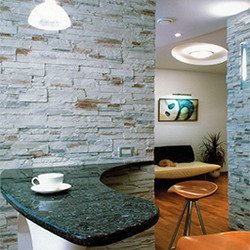 Since ancient times, stone has been used by man to construct all kinds of buildings, from ordinary residential houses to luxurious royal palaces. This material was present in abundance, and then, probably, few would have thought that after several thousand years only wealthy citizens would be able to afford natural stone. But if in ancient times people simply did not have an alternative to this material, then modern technologies have given us such an alternative, in the form of artificial stone. Is it as good as its natural counterpart, or is it still inferior? Is it worth paying attention to this material at all, since in essence it is nothing more than a fake? Let's try to figure it out.
Since ancient times, stone has been used by man to construct all kinds of buildings, from ordinary residential houses to luxurious royal palaces. This material was present in abundance, and then, probably, few would have thought that after several thousand years only wealthy citizens would be able to afford natural stone. But if in ancient times people simply did not have an alternative to this material, then modern technologies have given us such an alternative, in the form of artificial stone. Is it as good as its natural counterpart, or is it still inferior? Is it worth paying attention to this material at all, since in essence it is nothing more than a fake? Let's try to figure it out.
First of all, it should be noted that there are as many as 3 types of artificial stone. These are porcelain stoneware, agglomerate and concrete-based stone. Most often, interior decoration is carried out in apartments artificial stone specifically on a concrete basis, since this type of material has the widest decorative capabilities and relatively in a simple way production.
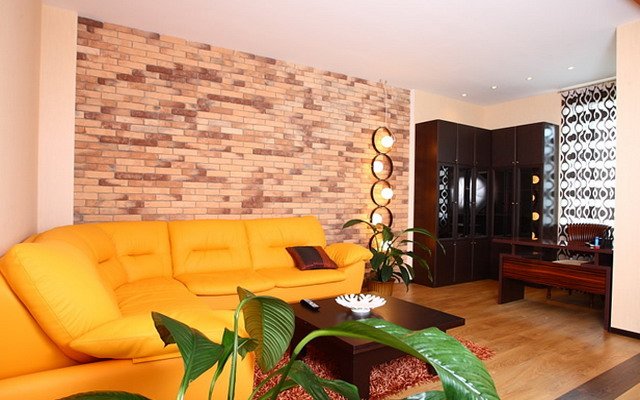
In short, artificial stone is produced by pressing under high temperature a working mixture consisting mainly of composite materials, mineral additives and acrylic compounds. Moreover, the share of mineral filler is at least 70%. Dyes are responsible for the external color and texture. In general, there are practically no restrictions on the appearance of the stone, thanks to which it can successfully imitate a wide variety of natural materials.
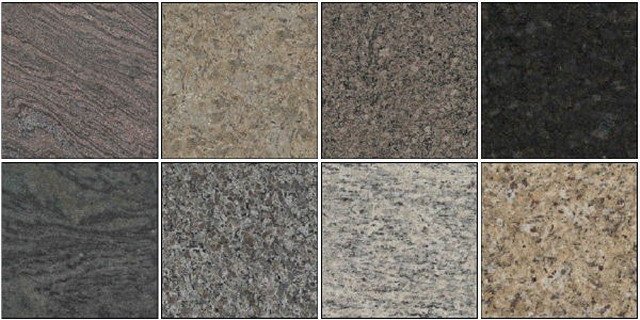
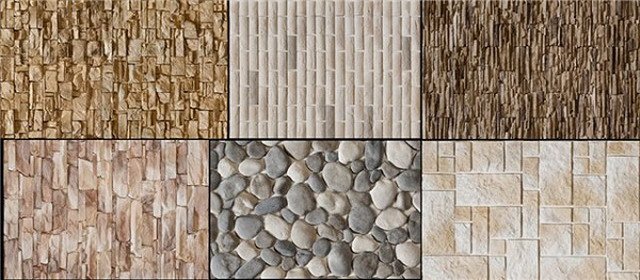
As you can see, the texture of two individual stones can differ significantly from each other, which, in fact, is why this material is so beloved by designers around the world.
As for the performance characteristics of the material, the most pronounced are the following qualities:
- Strength. The stone is able to withstand the strongest mechanical shocks;
- Durability. Service life is measured in decades;
- Environmentally friendly. There are no toxic compounds in the stone;
- Fire resistance. This finishing material is not subject to combustion at all.
As you can see, decorating the interior with artificial stone allows you not only to decorate the room, but also to make it much more technologically advanced and functional. Now, having understood the physical and mechanical properties of the material, let's take a closer look at its decorative component.
Artificial stone in the interior of an apartment - bringing your fantasies to life
The design possibilities that artificial stone provides probably cannot be provided by any other finishing material. His versatility is nothing short of amazing. With equal success, stone can be brought into the interior of any room, any without any exceptions. This could be a living room, bedroom, kitchen, bathroom, toilet, etc. In addition, artificial stone is not necessarily laid on walls or floors - all kinds of countertops, sinks and sinks are quite successfully made from it. Take a look at what artificial stone looks like in the interior of various rooms in the photo:
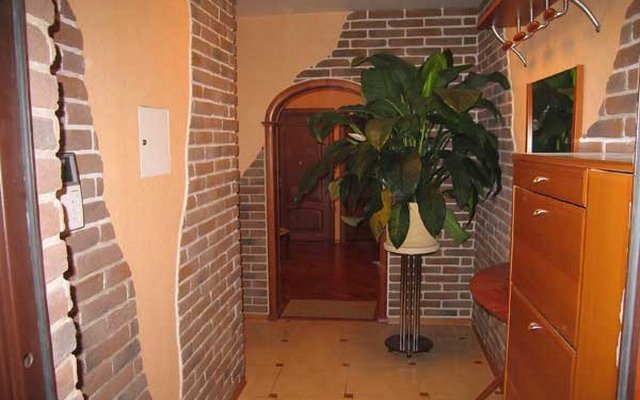
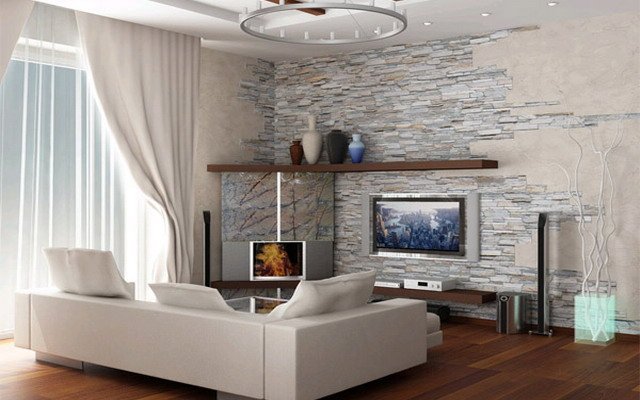
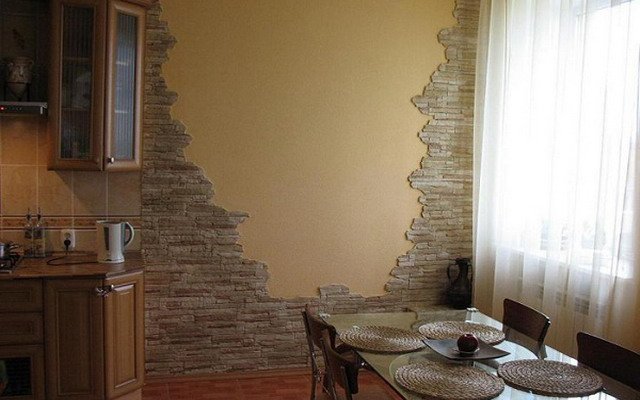
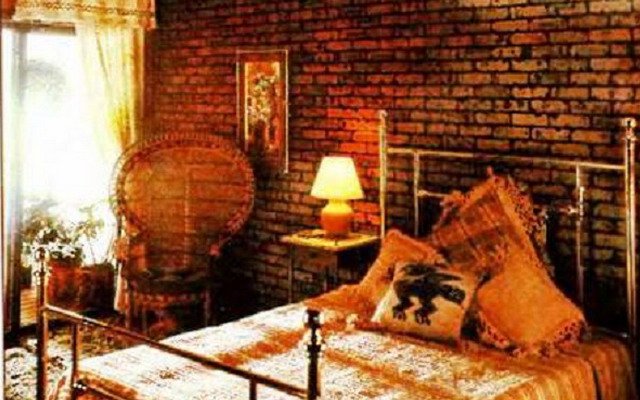
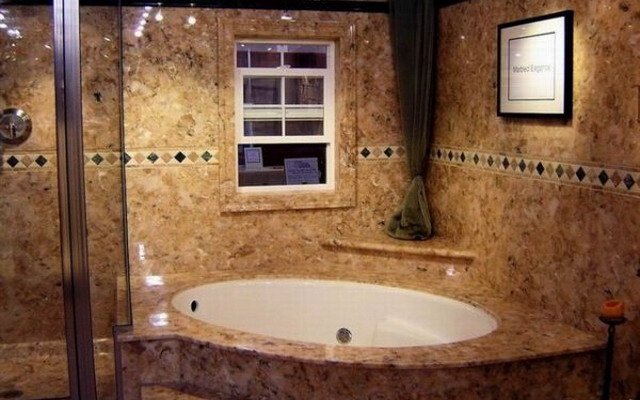
As a rule, artificial stone is used to create a refined atmosphere, to give the interior a touch of wealth and aristocracy. In this case, the stone is laid out on the walls, and in large quantities. At the same time, rectilinear forms and familiar figures with their inherent severity and steadfastness predominate:
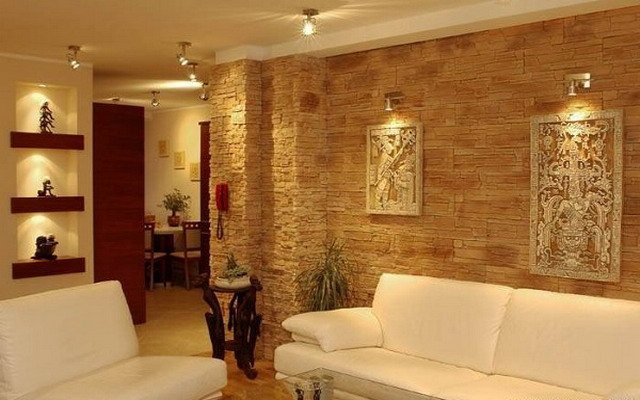
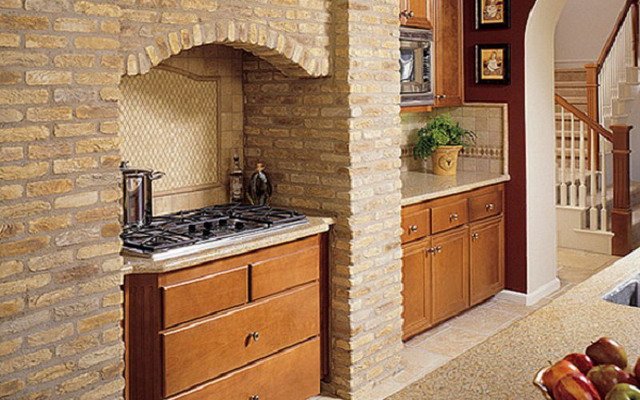
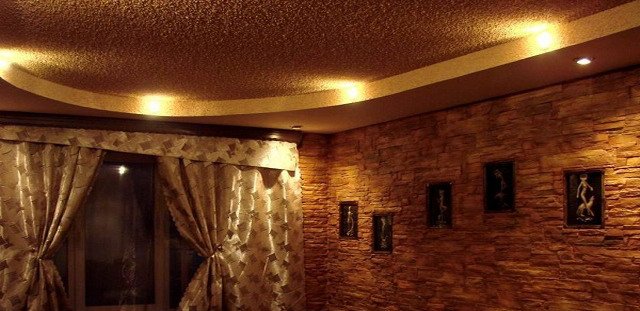
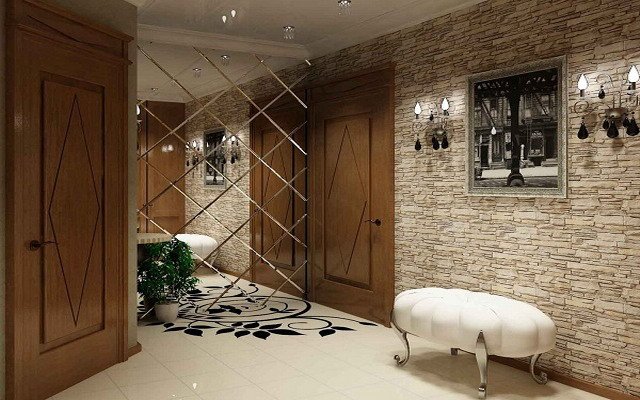
But this material can also have the opposite effect. So, under certain conditions, artificial stone will bring something wild and unbridled into the interior. Here the masonry has more chaotic shapes. The use of green plants is encouraged:
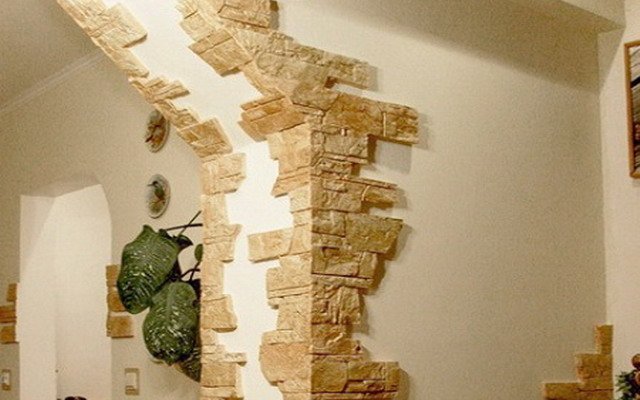
![]()
![]()
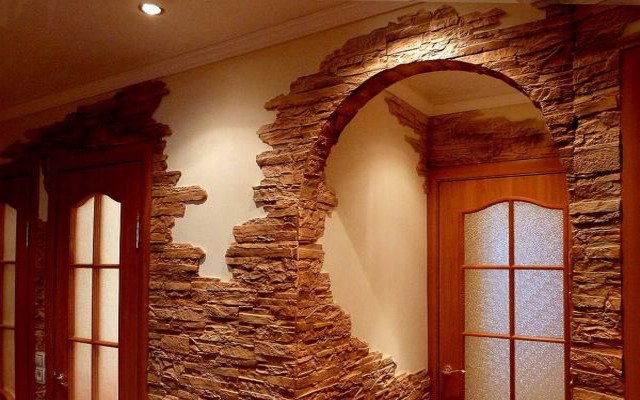
Decorative artificial stone can be laid out in the interior of the house in various ways, in different quantities and in different places. There are practically no frames. Still, there are some basic techniques that have been successfully used by thousands of designers around the world for decades. Let's take a closer look at them.
Interior decoration with artificial stone
After laying stone directly on the walls, edging doorways with it is perhaps the most common, but no less interesting option application of the material. In this case, the stone can cover the entire corner of the doorway as a whole, and can also be located on adjacent corners of the room:
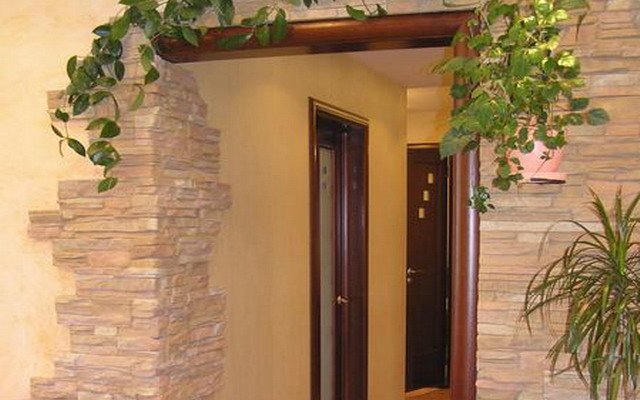
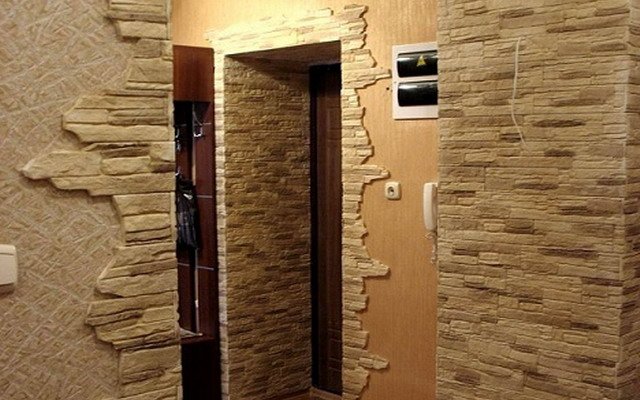
Niches and shelves are welcome in the interior of the apartment
Niches lined with artificial stone, with shelves located inside them, or separately hanging shelves against the background of a stone wall will be an excellent solution for decorating a bedroom, hallway or living room. Well-lit, such interior details can become a place to store items of your pride, for example, some awards, diplomas or certificates. Otherwise, you can place here ordinary souvenirs, flowers, or, at worst, a collection of movie discs:
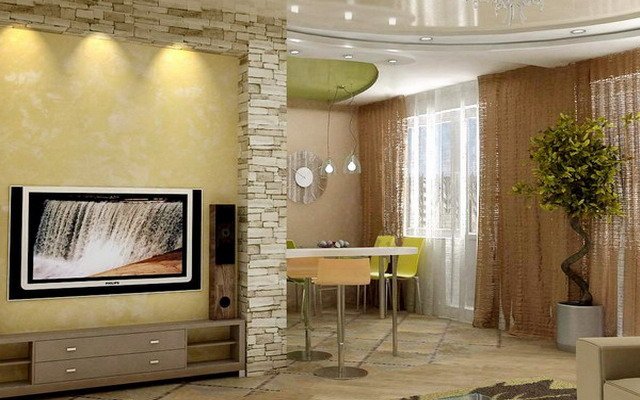
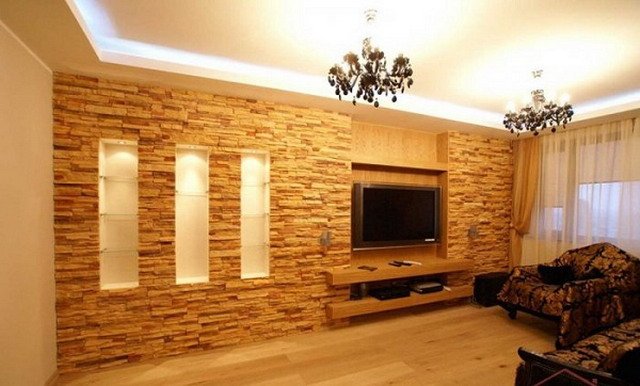
![]()
Decorative stone in the interior of a bedroom
When using decorative artificial stone in the interior of a bedroom, you should be especially careful. Here it is necessary to maintain an optimal color balance, and it is desirable that light colors and shades predominate in it. Psychologists have long confirmed that color has a huge impact on a person’s mental state, and if this fact is important anywhere, it is definitely in the bedroom. Give preference to colors such as white, beige, light blue, gray, etc. It is allowed to use soft brown and even black, but only in small quantities - as accents. It’s good if furniture plays the role of accents. As for where to use stone in the bedroom, it will look especially good on the wall behind the bed. You can also hang one or more paintings here:
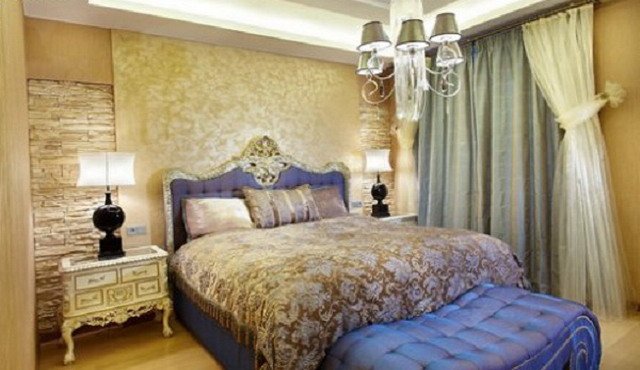

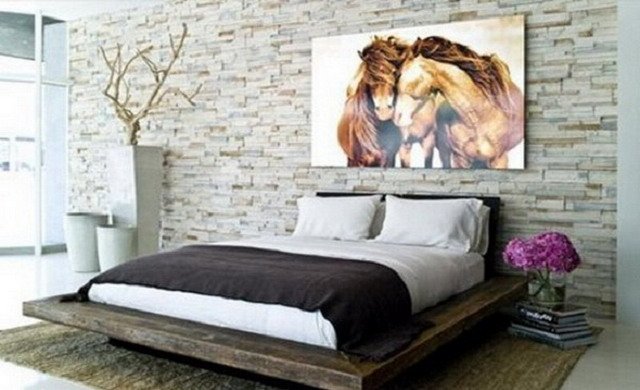
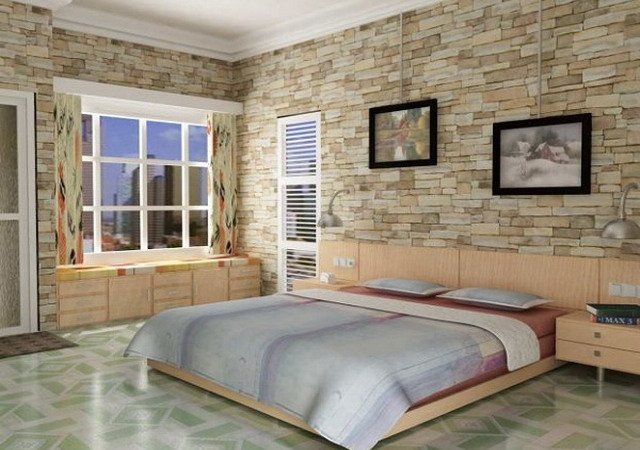
Striped walls of artificial stone in the interior
As we have already said, the stone does not have to be laid on the entire wall. But hitherto we considered partial installation exclusively as chaotic, which is not entirely correct. The interior decoration with artificial stone in the form of straight lines located at a certain distance from each other looks quite good. These lines can be located both vertically and horizontally, although the second option is still more common. You can see what it looks like in the photo:
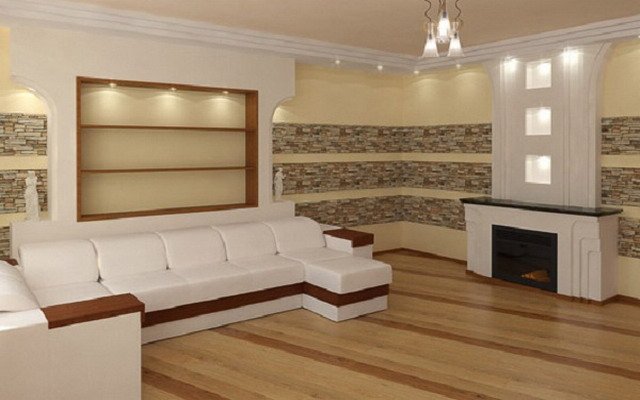
The greatness of columns made of artificial stone in a quartite
If you do not experience problems with a lack of square meters, then excellent option The use of free space will be the construction of columns. Moreover, these do not necessarily have to be free-standing columns. They can be imitated in the corners of the room. Artificial stone is ideally suited for this task. It will fully convey all the grandeur inherent in these massive structures:
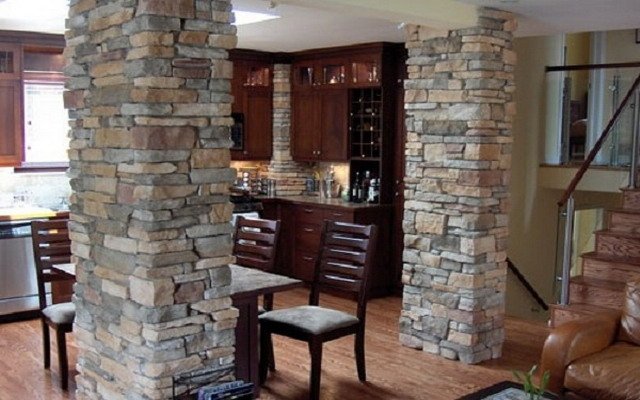
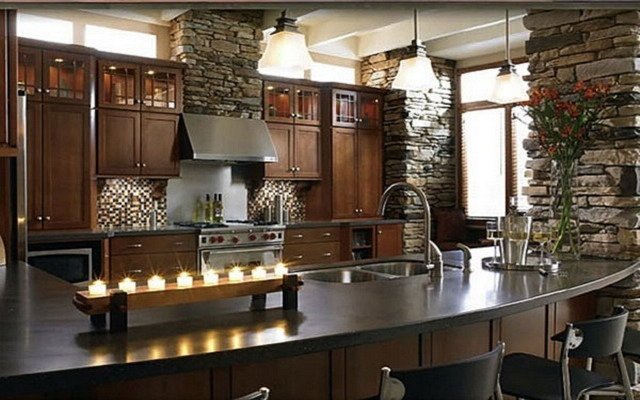

![]()
That's all we wanted to tell you about how artificial stone is used in the interior of an apartment. We hope that the article was interesting and useful for you. When choosing artificial stone to decorate your home, you definitely won’t miss it!
Artificial stone is one of the few materials produced using modern technologies, but bearing the stamp of past eras. Proper Use artificial stone in the interior of the living room, as in the photo, brings into the room an element of some negligence and incompleteness. Emphasizes the personality of the owner, his taste and individuality.
The use of artificial stone and its properties
And although the artificial material only imitates natural stone, its characteristics are no worse than its natural counterpart. Perfectly replicating the structure of the original, its color, shape, size, this option is used in the decoration of rooms for various purposes, including the living room.
Pay attention! Artificial material will also look good in combination with other facing options. It is combined with ceramics, vinyl wallpaper, plaster, and wood. Suitable for plaster stucco and forged forms.
In terms of its characteristics, artificial stone is similar to its natural counterparts, but is lighter in weight and easier to transport and install. Because of large quantity has types and colors various options used in finishing the facades of buildings and interior decoration of rooms.
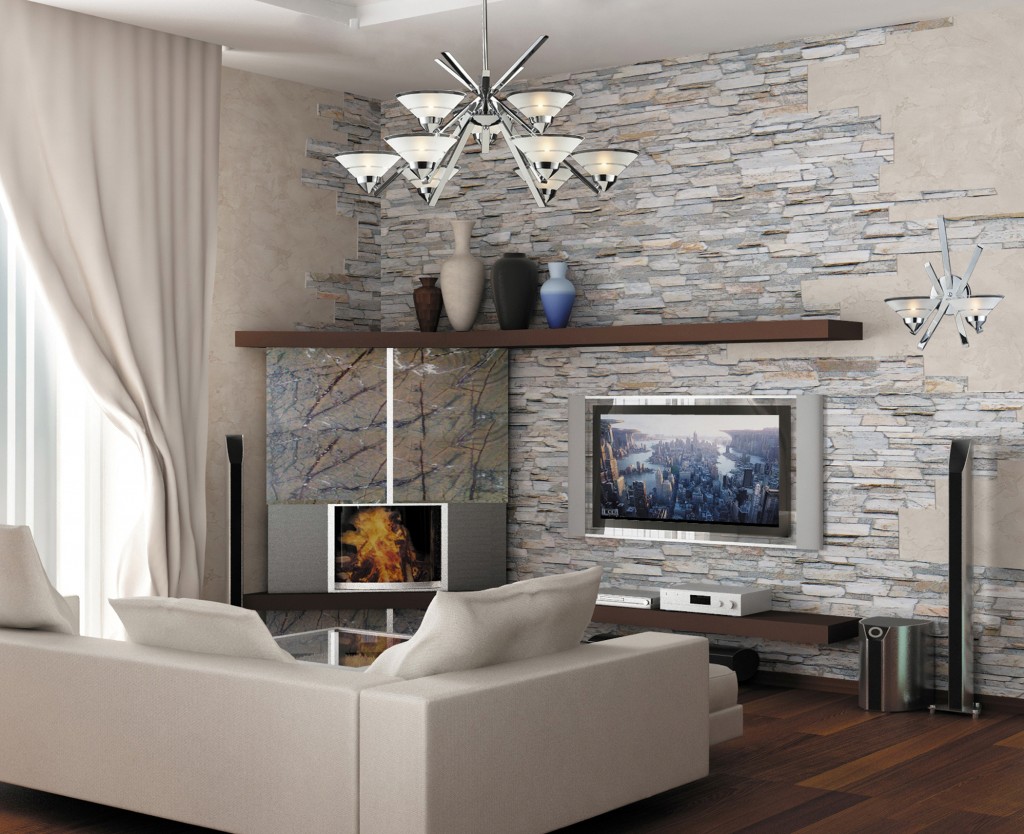
The artificial stone used in interior decoration has the following qualities:
- Durability. The service life of such cladding is several decades;
- Easy to install. The flat surface of the reverse side allows you to glue it like a regular tile on any material;
- Resistance to temperature changes, which is used in the decoration of natural and artificial fireplaces;
- Easy to care for and no special treatment required. It may be sufficient to occasionally wipe the surface with a damp cloth and a mild detergent;
- The acceptable thickness of the artificial stone (about 2 cm) allows you not to reduce the space of the room.
Living room finishing options
Charisma and brutality, severity and majesty - this is what characterizes living rooms decorated with stone. Which design option to take as a basis depends on the wishes of the owners. Designers suggest using one of these projects:
- Trimming arches, doorways, corners in the living room. Can be used to fill the entire surface or apply individual patches. In addition to the aesthetic side, such a solution also has a purely practical meaning: the vulnerable surface of the walls is protected from scratches and other mechanical influences;
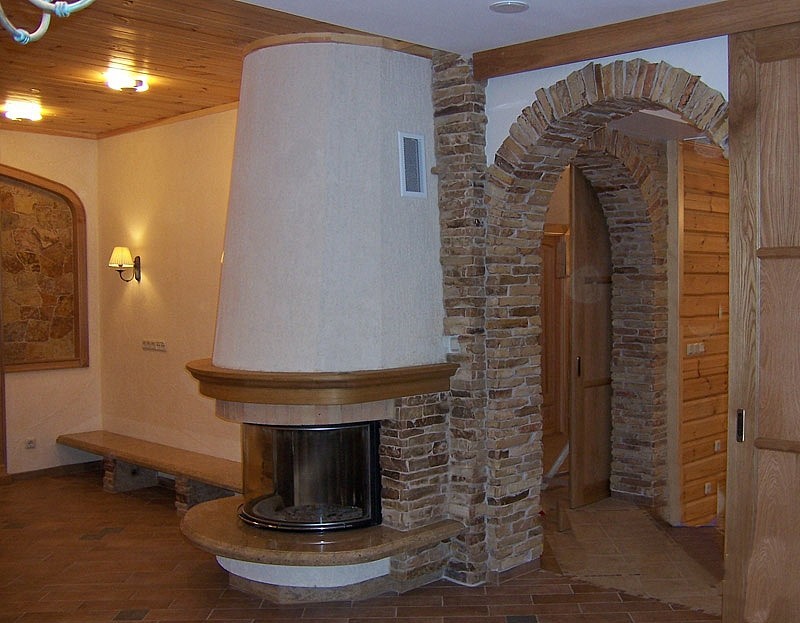
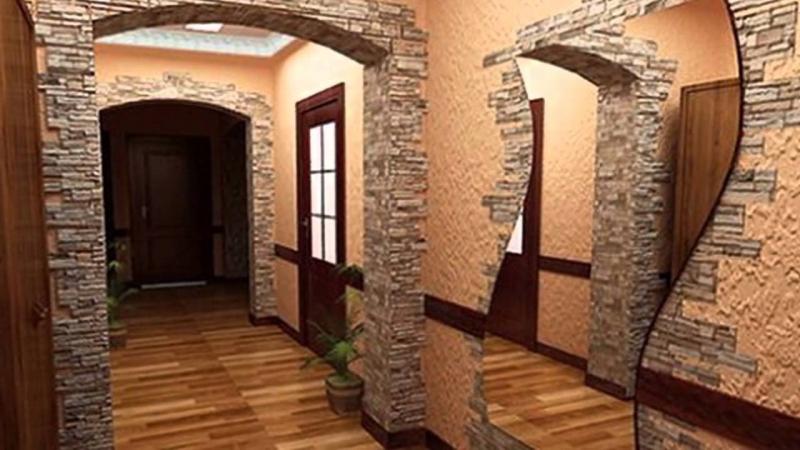
- Stone decoration of one of the walls. The rest are wallpapered or painted to match. Against the background of such a surface, a modern thin TV will look impressive;


- Filling shallow niches and shelves with stone, in the upper parts of which will be built spotlights. Such illuminated elements bring a sense of mystery and fairy tale to the living room;

- Partial wall decoration, which looks much more interesting than a completely stone-covered surface. Various background elements will add lightness and mystery. You can cover the center of the wall with wallpaper, and cover the side parts so that the edges are uneven. An antique lamp or a painting in a classic frame will complete the creation of such an interior;
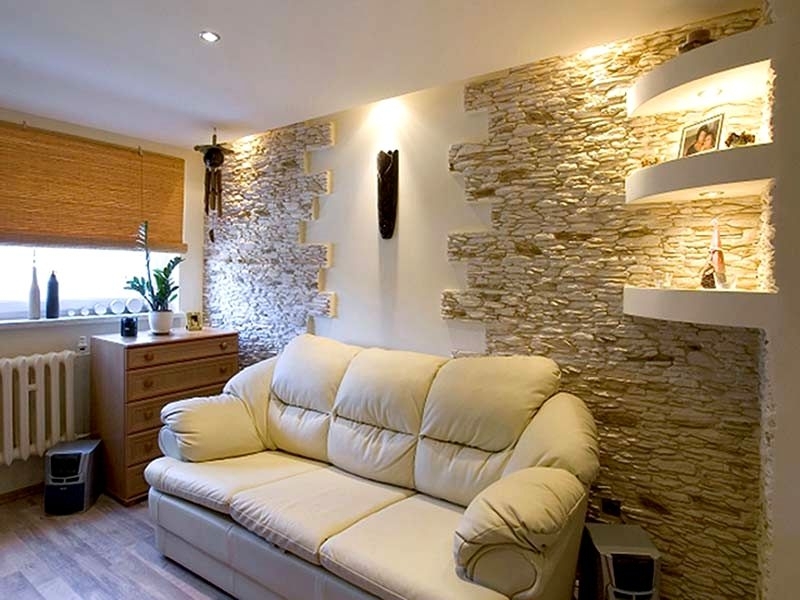
- A plasterboard partition dividing the living room into two zones looks great when decorating its surface with a similar material;
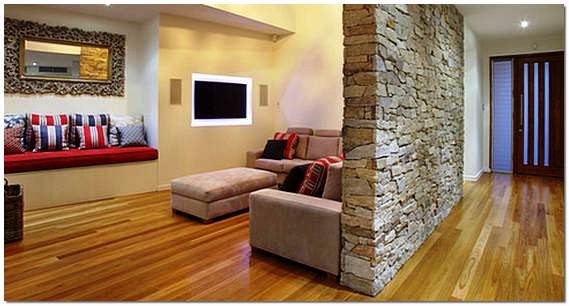
- Stone floor cladding. There are many artificial options that will fit well into the interior of an apartment or country house.
Separately, it is worth mentioning the design of the fireplace. If it is planned in the interior of the living room, it will look great using artificial stone finishing, as in the photo. This material can be used to cover either the entire wall, or only the surface of the heating device itself and a small part nearby.

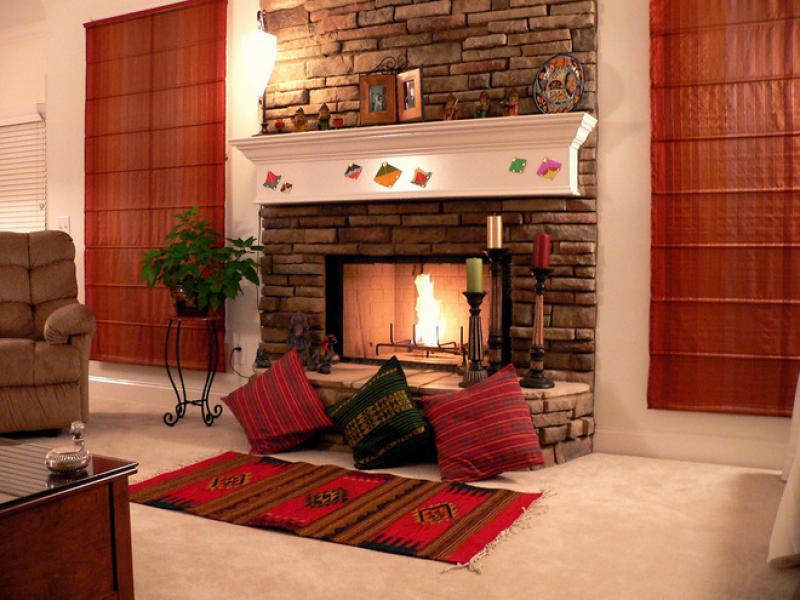
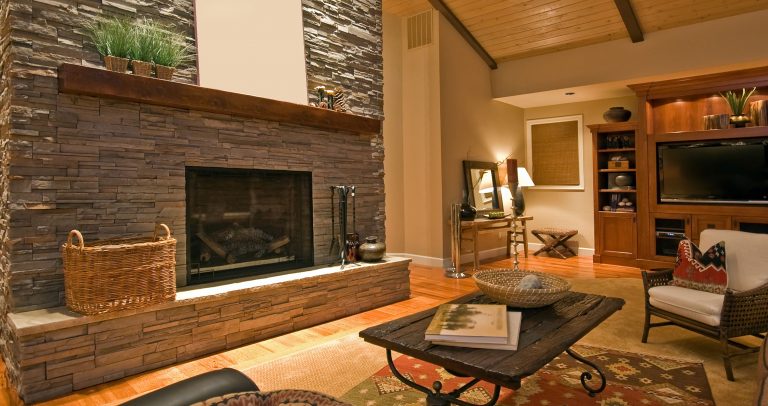
Types of artificial stone
There are three main types of this material. Depending on the incoming components, manufacturing technology and scope of application, you can purchase porcelain stoneware, agglomerates or colored concrete stone for finishing your apartment.
Porcelain tiles
It is made from various types of clay, feldspar, and mineral additives by pressing under high pressure. Has appearance like ceramic tiles with a matte, glossy or embossed structure. Looks great on walls and window sills. But more often it is used to create a beautiful floor. Ideal for living rooms in modern styles, such as modern, hi-tech, minimalism. Looks good in English design too.
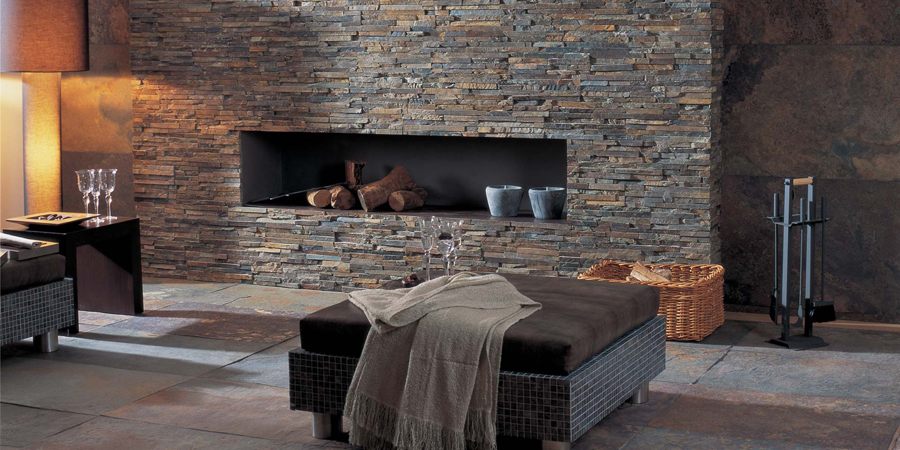
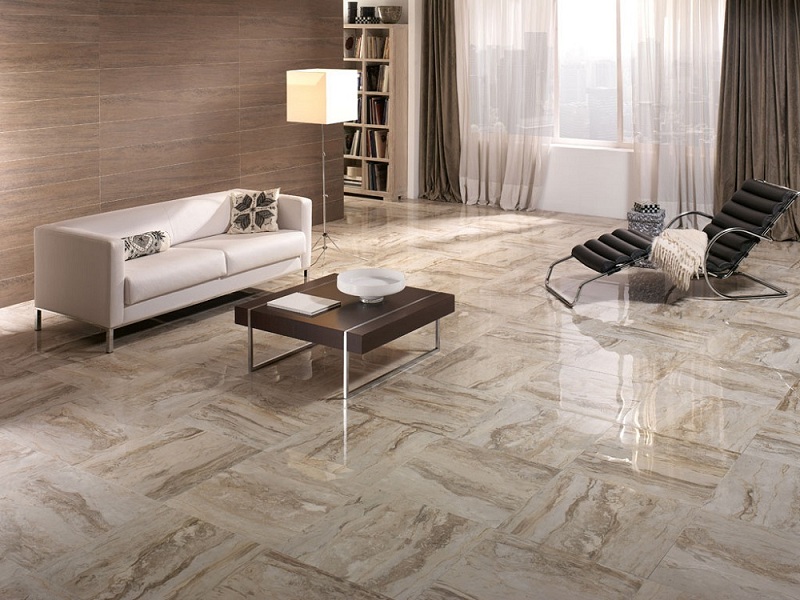
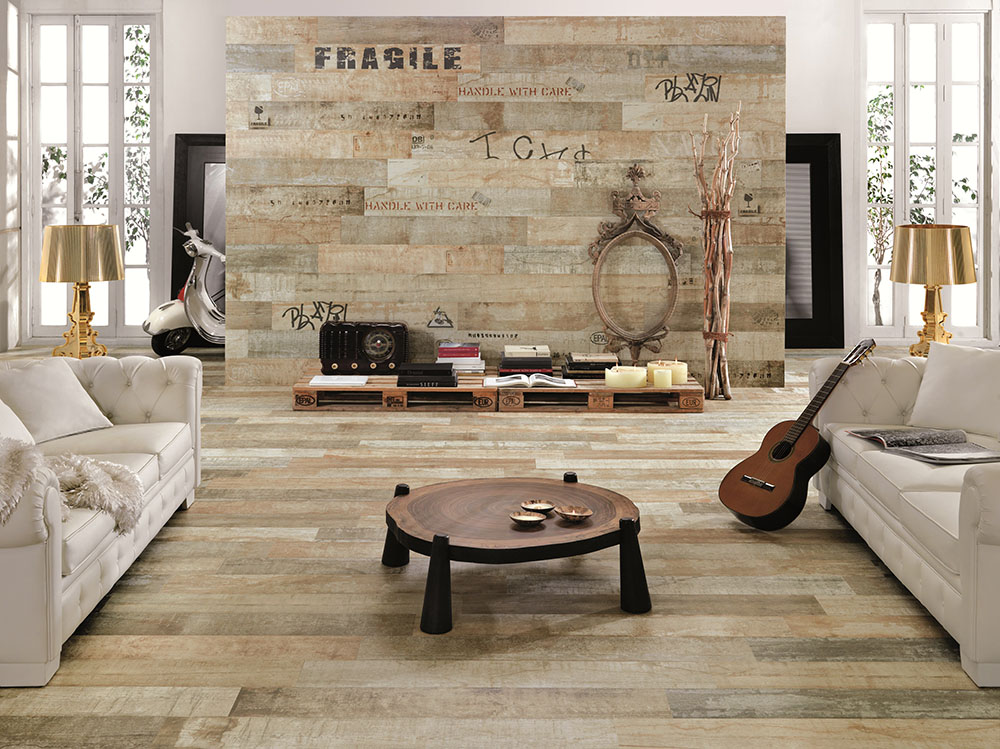
Agglomerates
Consisting of polyester resin with various fillers (marble chips, limestone, granite), the agglomerates are similar to all kinds of natural stones, and also have original colors using mirrors and glass. Characteristics include durability and wear resistance. It is used for finishing walls, window sills, and looks great in fireplace linings.
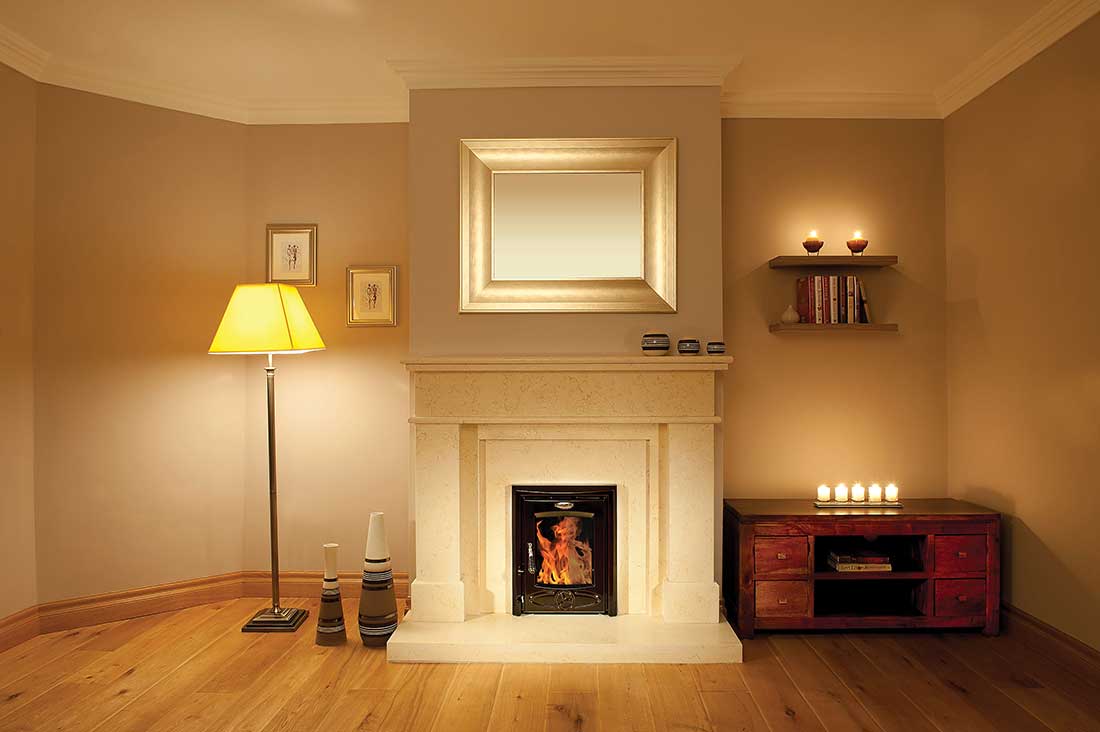
Colored concrete stone
Consisting of sand, Portland cement, expanded clay, pumice, and dyes, this artificial material looks good in interior decoration. According to its characteristics, it is close to concrete. It has a beautiful appearance and versatility, thanks to which it is used in the decoration of living room walls.
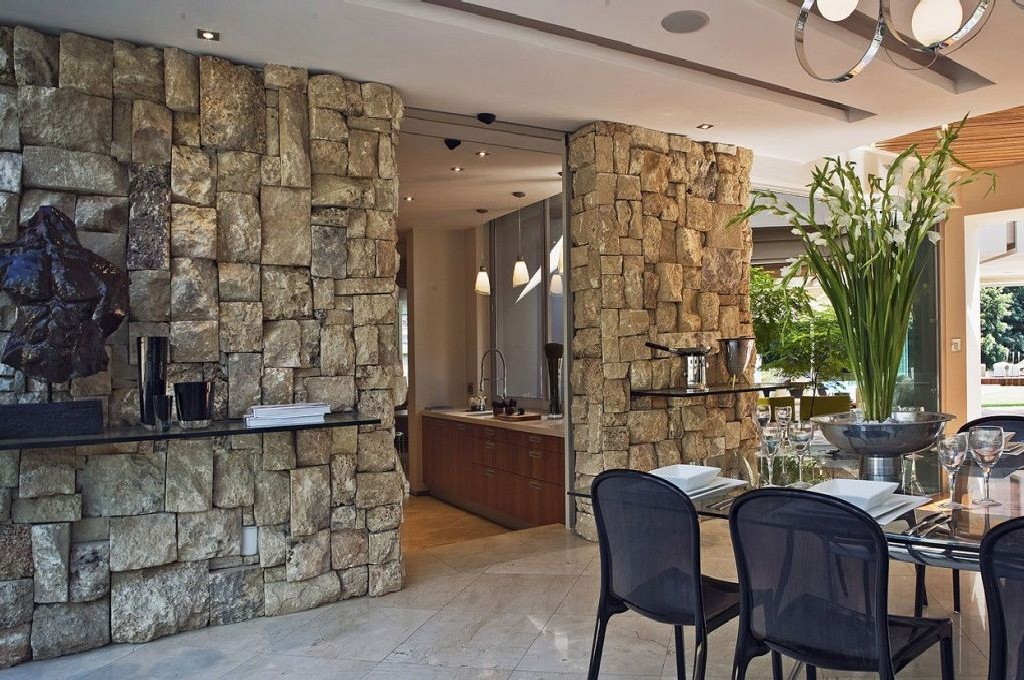
When deciding to use stone in interior design, you should listen to the advice of experts. The correct presence of such finishing will give the living room originality and uniqueness. Otherwise, there is a risk of turning the room into something like a dark, gloomy cave.
- There is no need to decorate all the walls in this way, especially in an apartment. Living in a stone well is unlikely to be comfortable;
- It is not customary to use more than two types of stone. Only a specialist can correctly combine different textured surfaces;
- Use this finish more carefully in small living rooms. Choose light samples, they will not allow you to “eat up” the space;
- The lighting system must be carefully planned because the stone can absorb light.
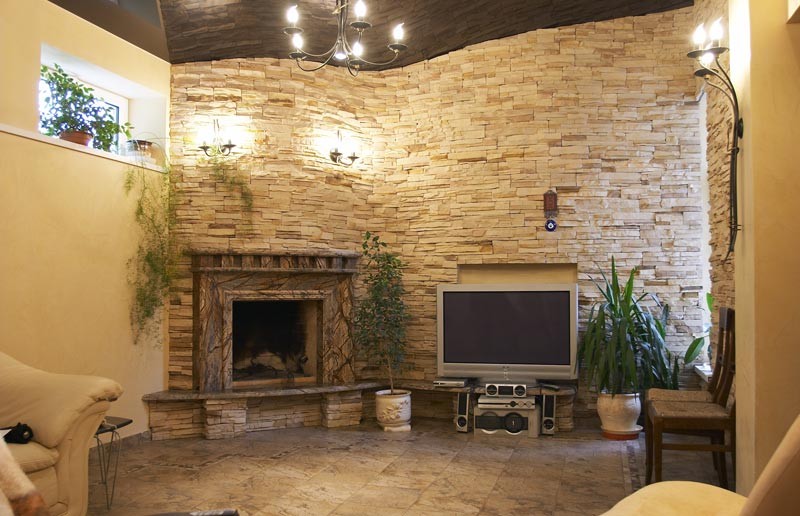
Modern design solutions fit artificial stone into the decoration of any room. But you shouldn’t overload the space with such heavy decor. By observing moderation and choosing the right color of stone with a certain texture, you can create a light and sophisticated home interior even from such a seemingly solid, serious material.
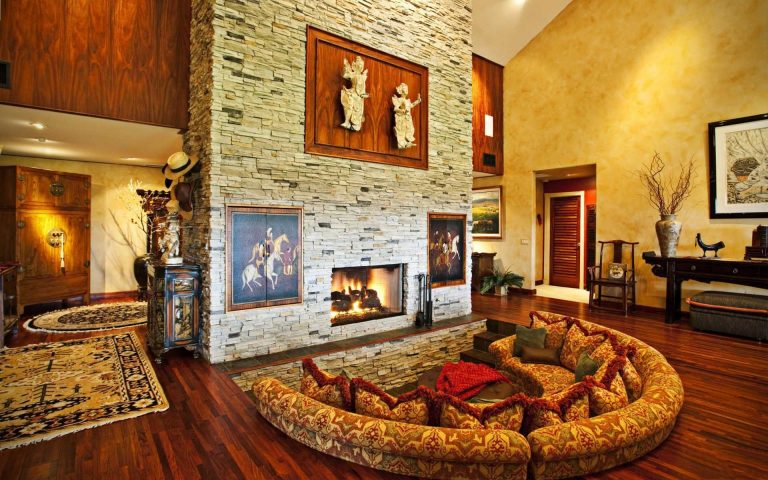
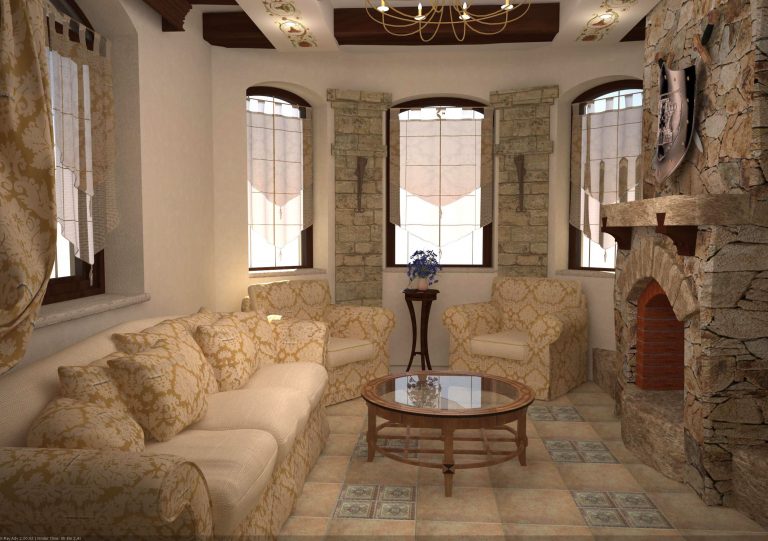

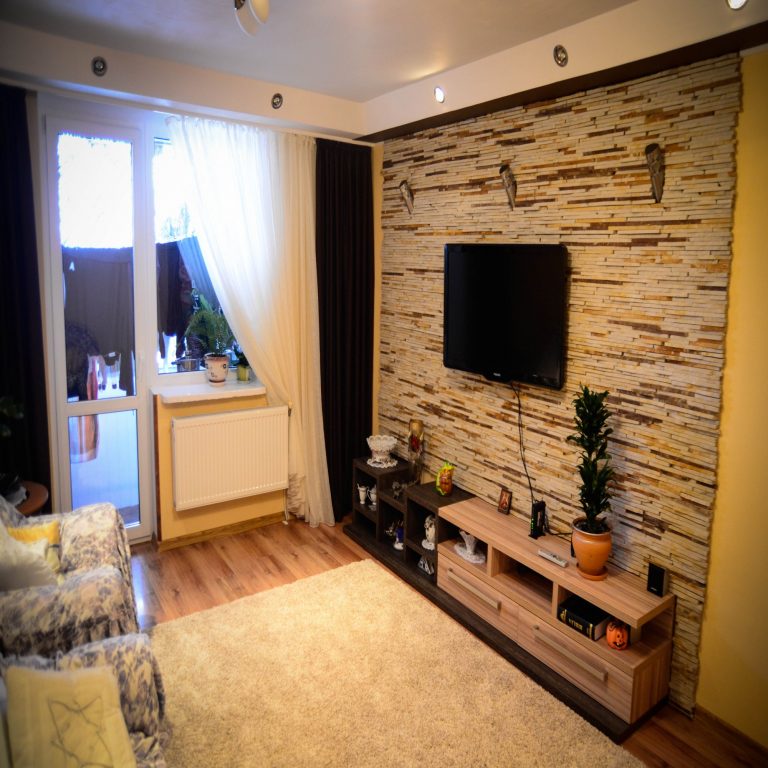
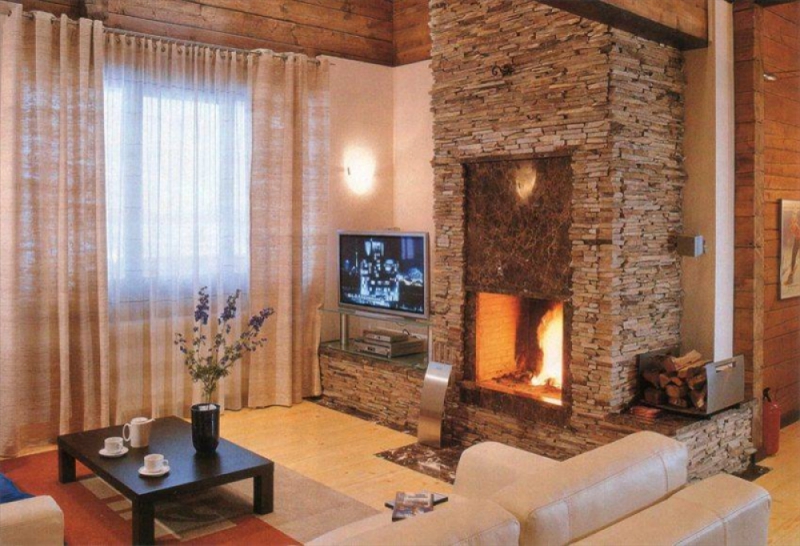

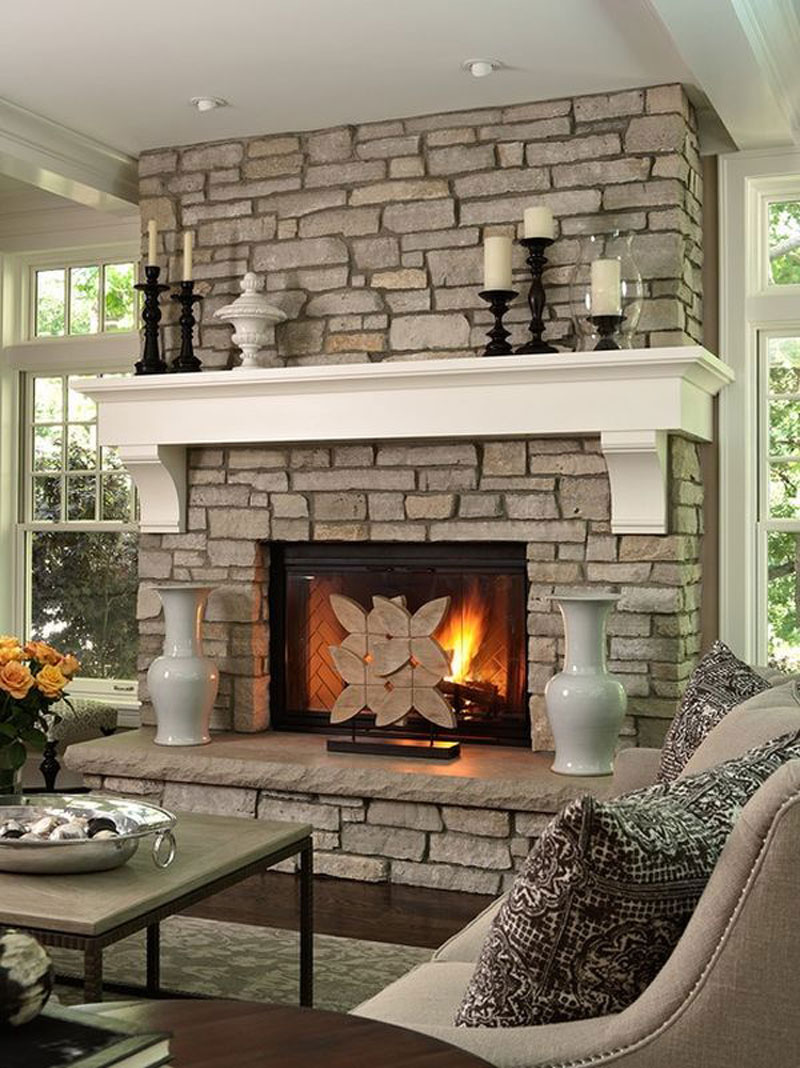
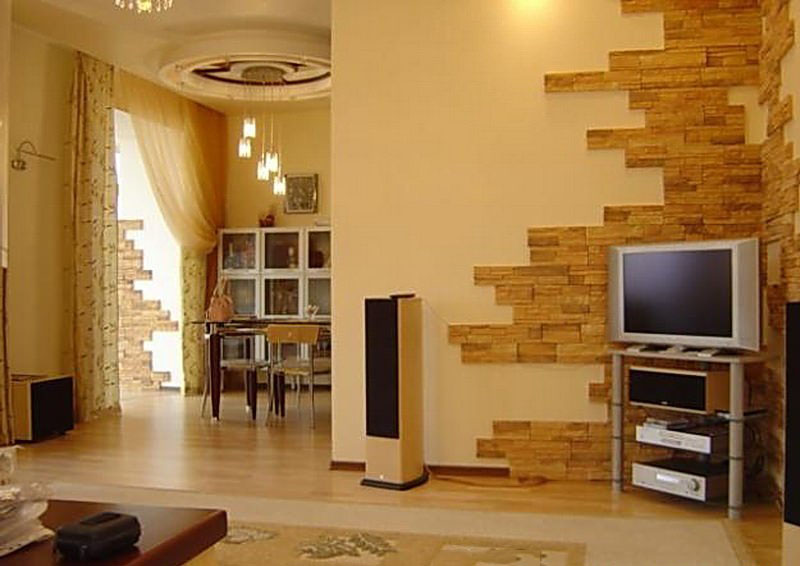
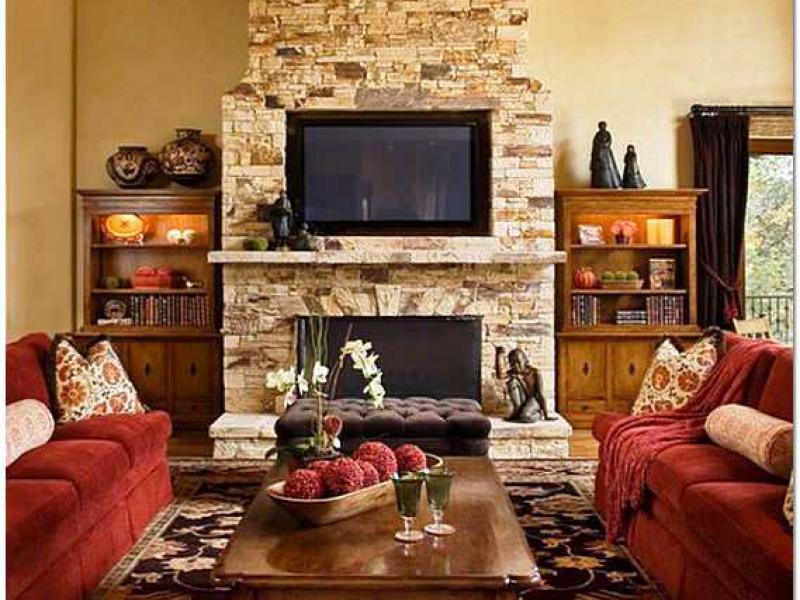
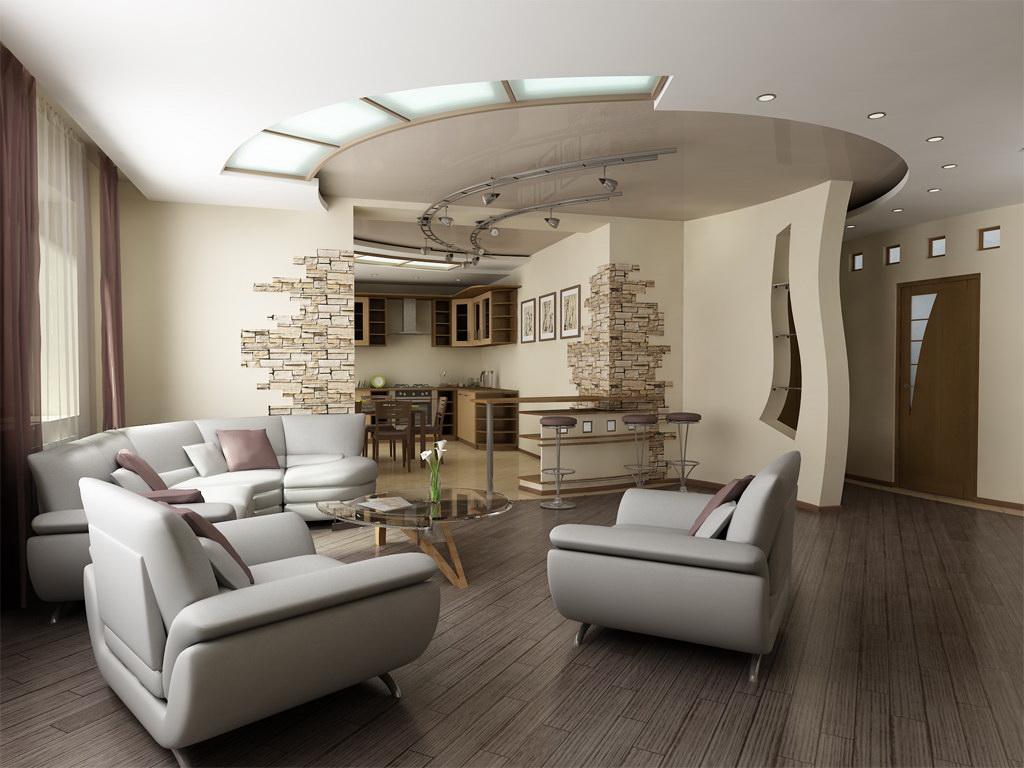

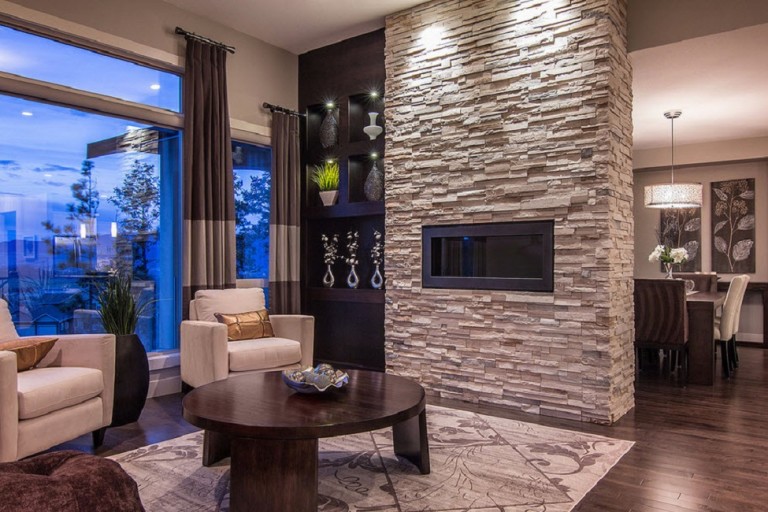
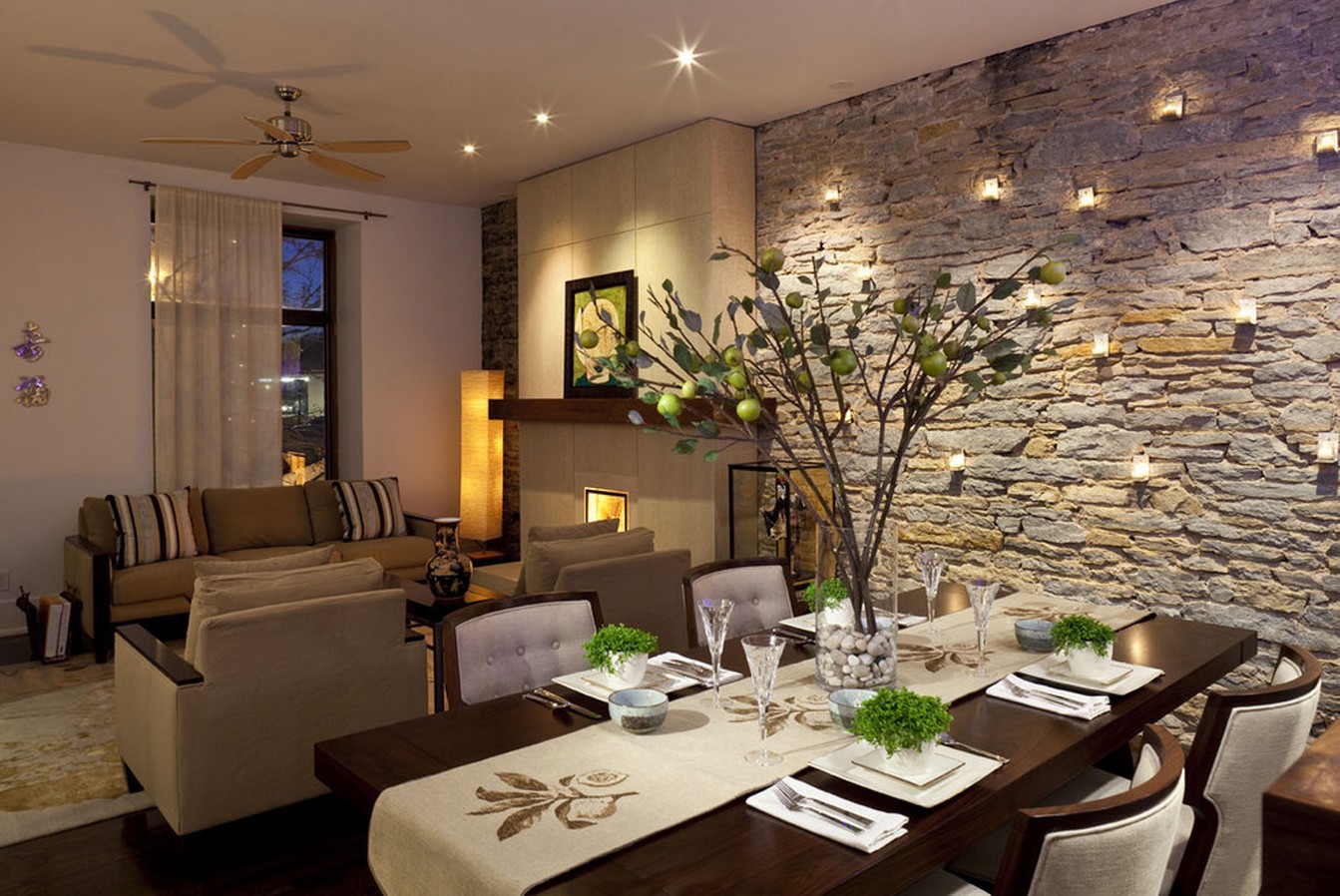
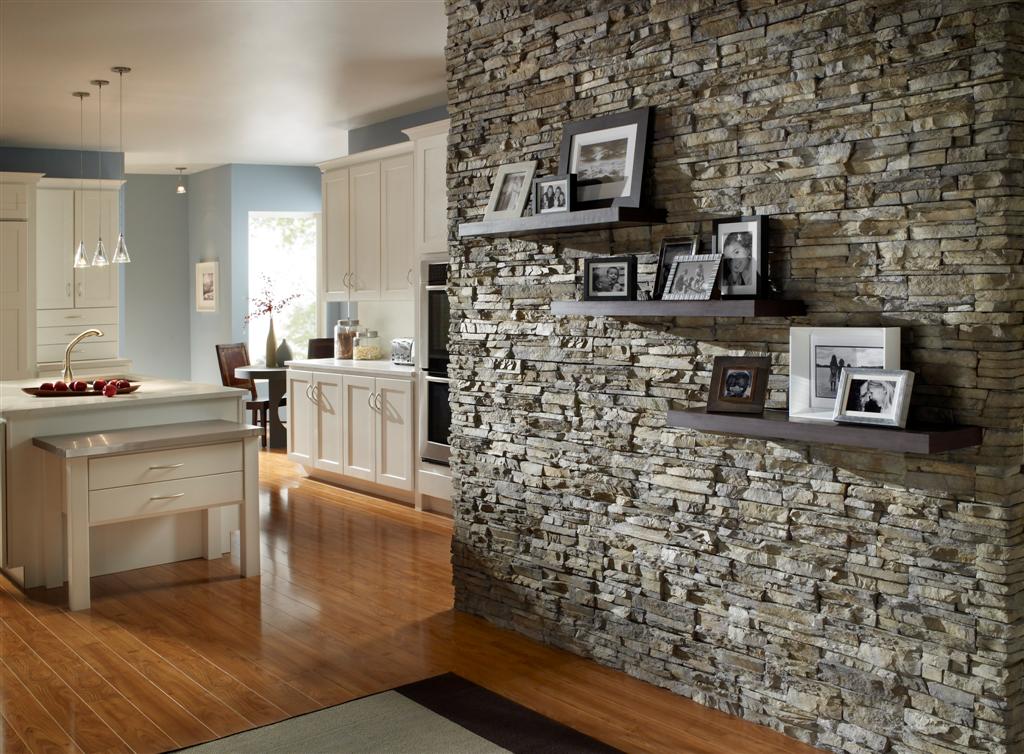

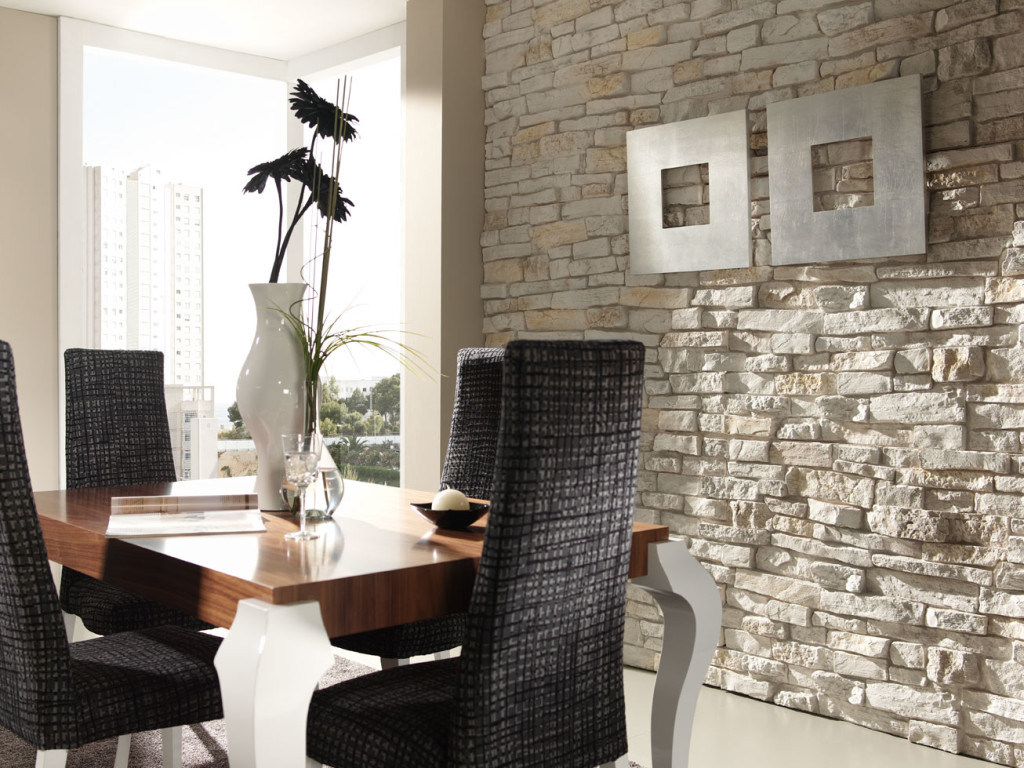
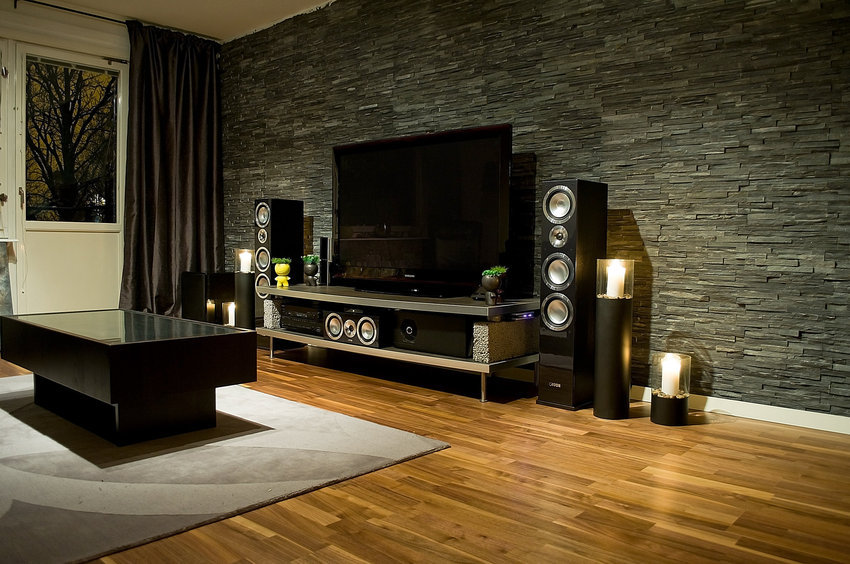

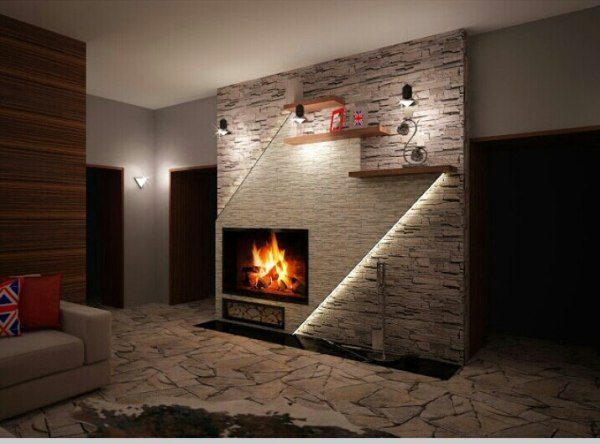
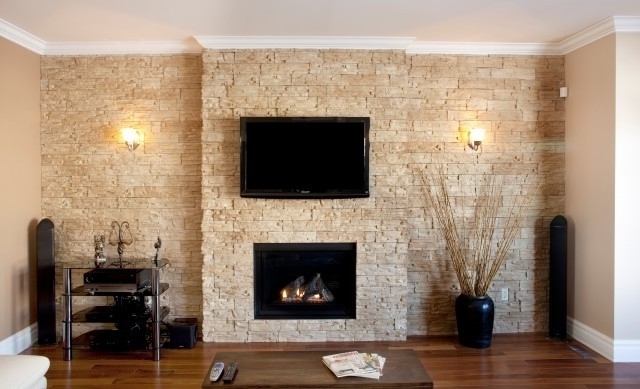
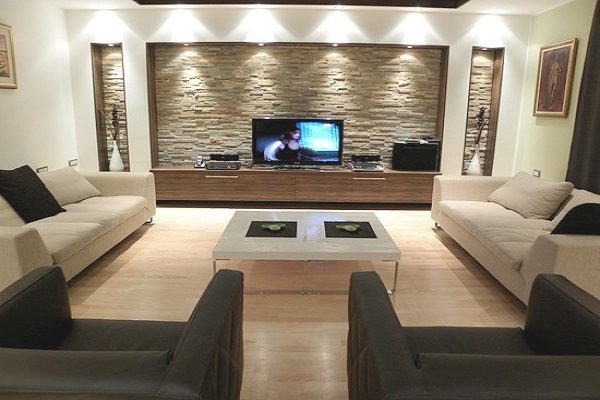
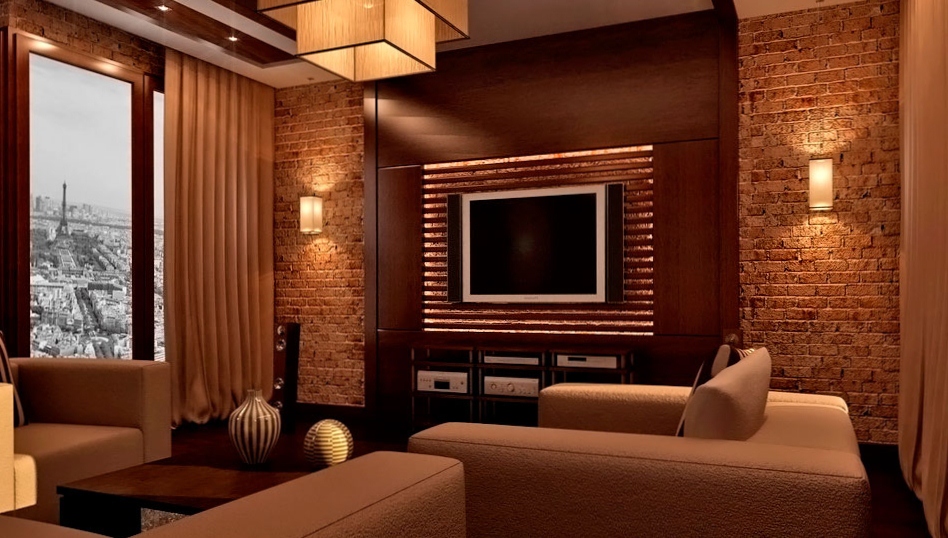
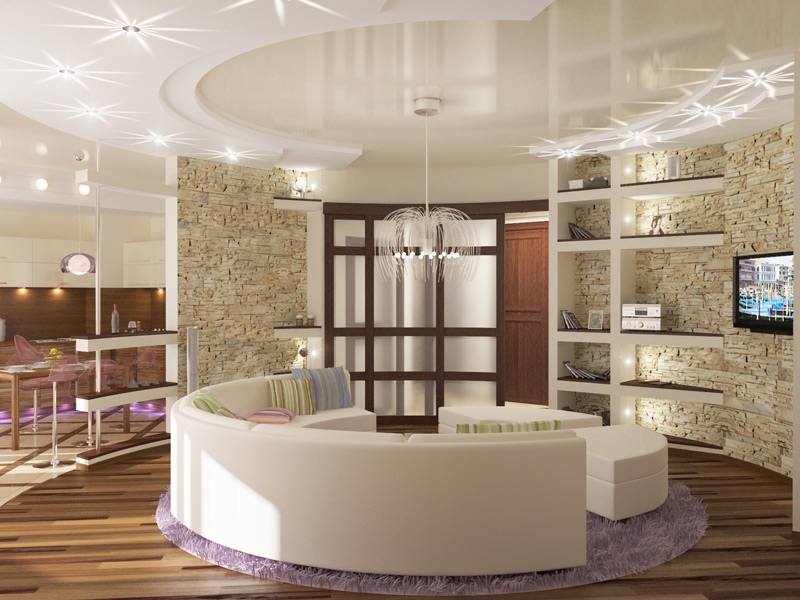
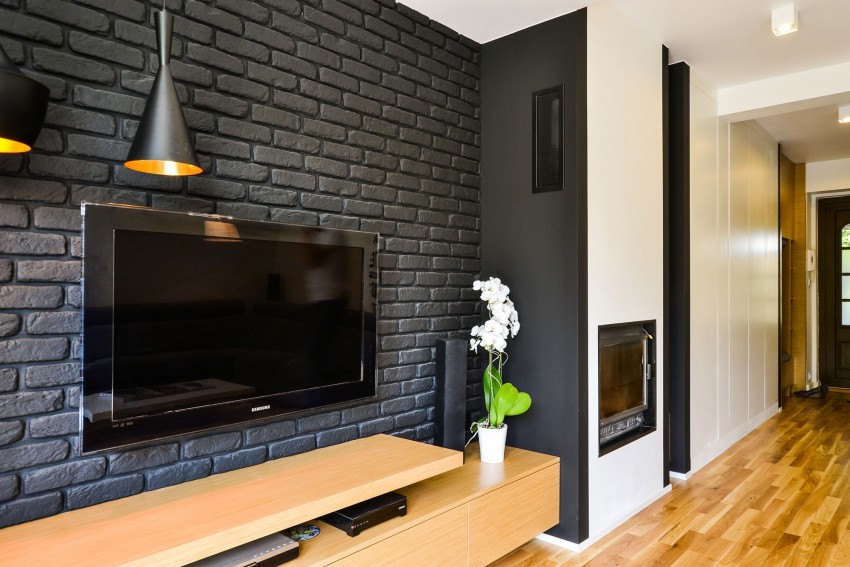


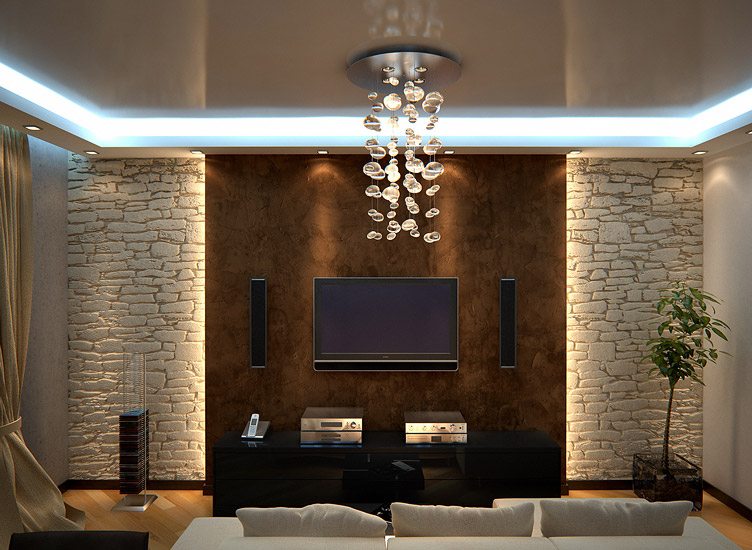
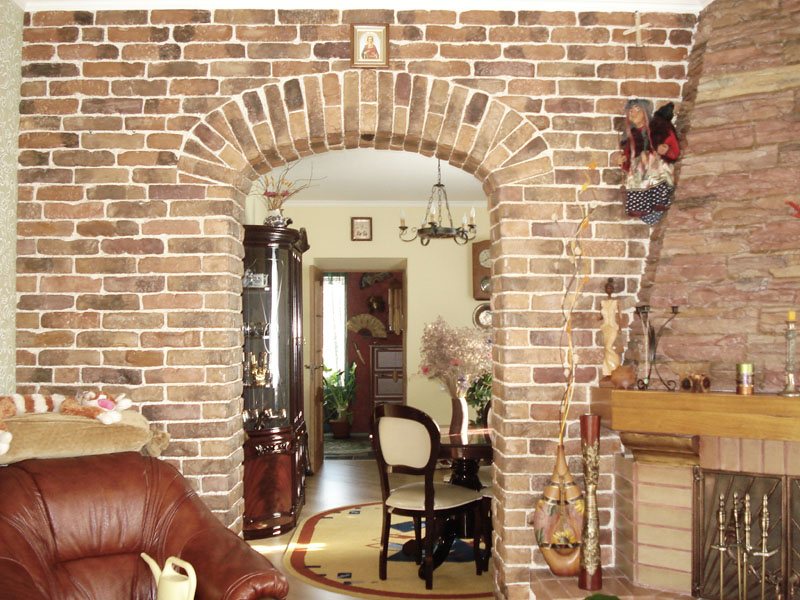
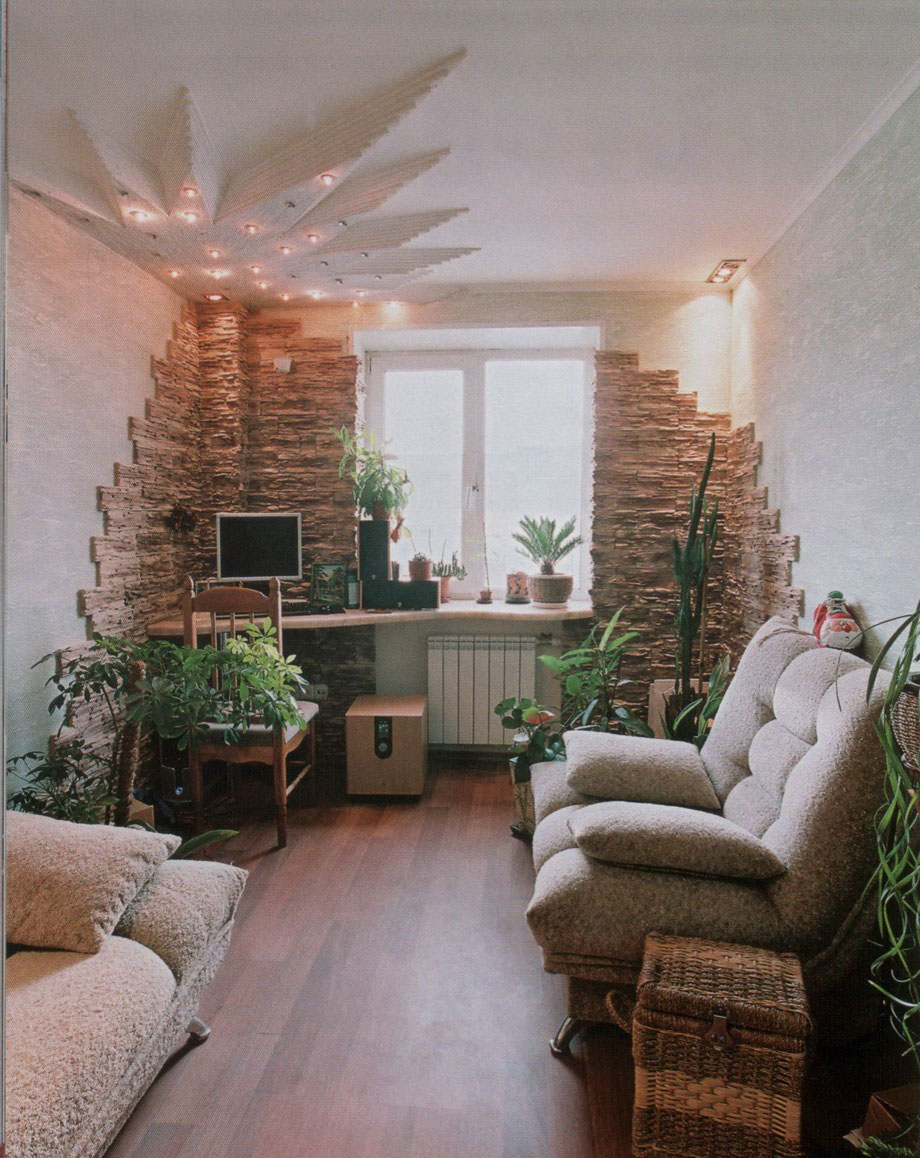
Designers in 2017 are calling for the use natural stone in the interior. It's good to tell them! We live in standard high-rise buildings. No problem: we’ll figure out where, how and what kind of stone will suit your “ordinary” apartment, and how to make repairs without problems. So…
-
- 1. Natural stone
- Beauty
- What to consider
- Price issue
- 2. Artificial stone
- Beauty
- What to consider
- Price issue
-
- Beauty
- What to consider
- Price issue
- 1. Natural stone
Stone in the interior of an apartment: fashionable, not cheesy
Of course, stone loves scale and space; it fits elegantly into the interiors of cottages and villas. But what should we, small-sized city dwellers do?
A small apartment is not a death sentence! Following stylistic rules, stone can be easily used in literally any living room in high-rise apartments. In a small apartment, the main principle is to use it in doses.
A fireplace, even an artificial one, with a stone finish turns a typical room into a stylish living room. Stone is the ideal highlighting element. If you need to divide the room into separate zones, then using stone segments in the decoration, you can easily cope with this task.
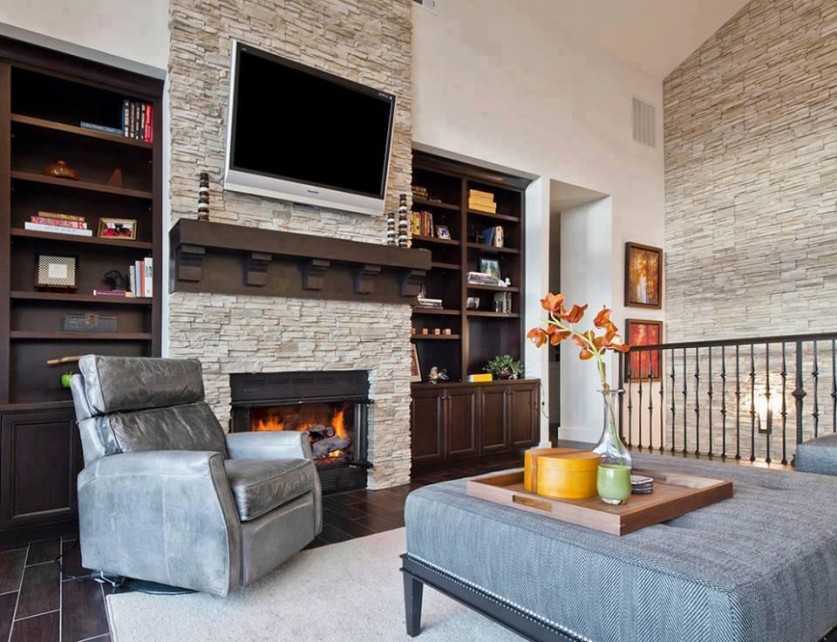
In the bedroom, the stone looks impressive at the head of a large solid bed. Or, conversely, decorate the wall opposite the bed so that the eye has somewhere to rest (note: in the second photo two types of stone-like surfaces are used).
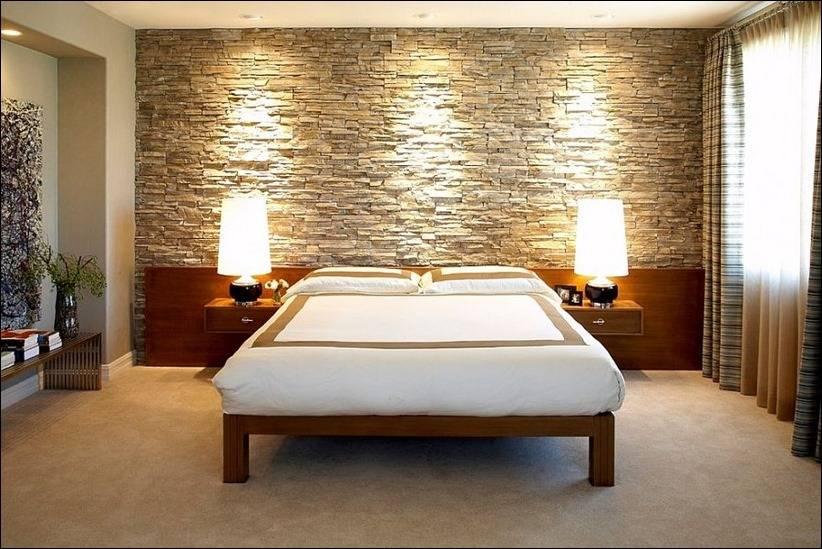
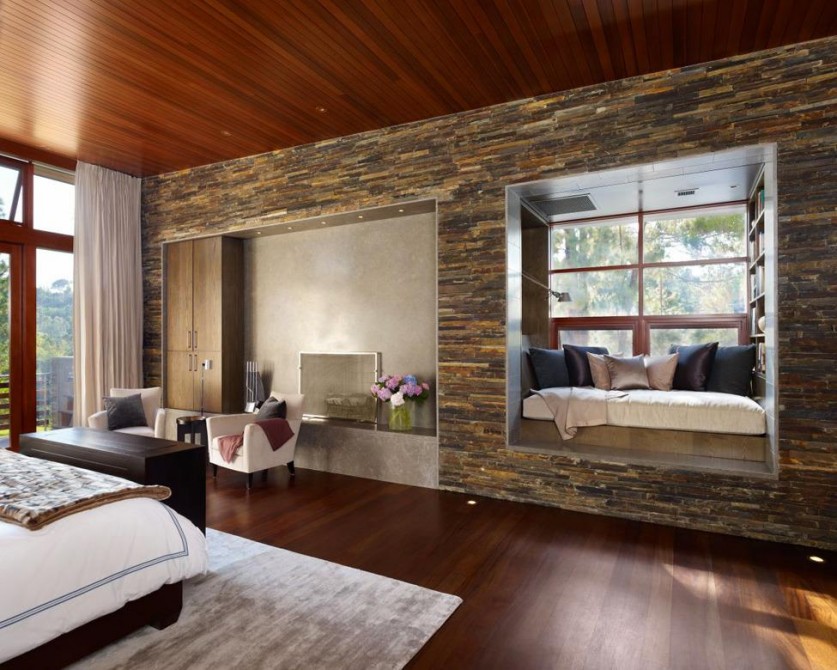


In the kitchen, you can line the apron with stone in the work area. However, choose a stone with a smooth shape and a coating, because the work area is a vulnerable place that requires specific care, frequent washing and cleaning. Well, a countertop made of monolithic artificial stone is already an almost classic solution for the kitchen of a modern apartment.
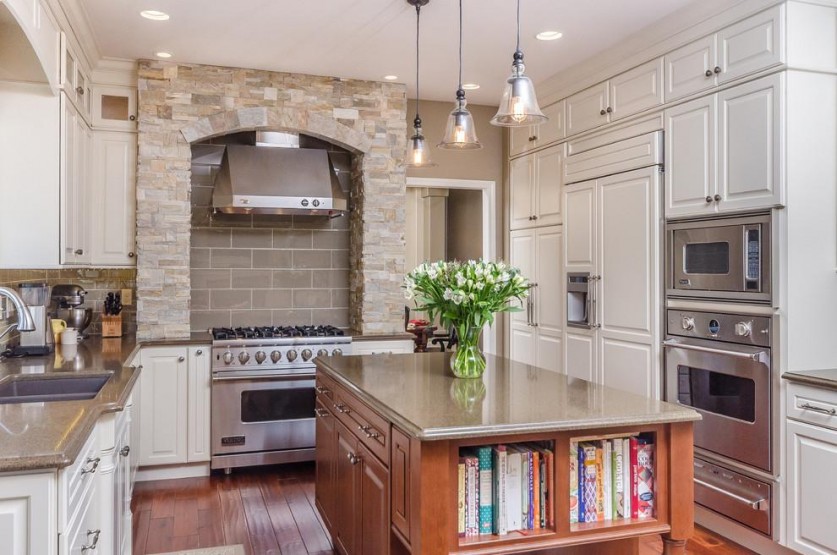
Stone panels look good in corridors, for example, around the mirror area. And the stone is ideal for the bathroom - a worthy replacement for boring tiles and ceramic tiles. Just don’t forget about moisture-resistant and anti-fungal adhesive for installation.
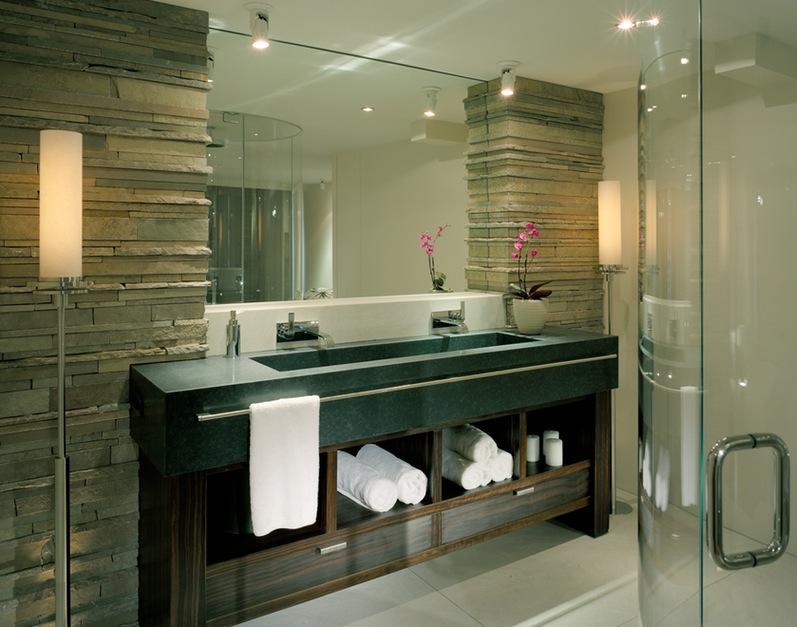
Even if the stone is used in doses, it is worth understanding that there are materials and styles with which it simply does not “get along.” It is difficult to combine stone elements with a romantic style, with airy textiles, and with “naive” accessories. Remember that stone in the interior is appropriate on walls where there will be no other decorative elements or where they will be contrasted with the stone in color and texture.
Natural stone in the interior is beyond competition; it actively occupies the entire space, accentuates attention and becomes the favorite of the interior. Therefore, a stone wall looks organic only in two cases:
- If the overall interior is calm, laconic, not overloaded small details and bright accents.
- If there is another object in the room that is equally powerful to perceive, e.g. panoramic window with a large view.
It is also worth understanding that the stone surface greatly “steals” the volume of the room. Therefore, if the room is small, then you should not “sew” it into stone, otherwise it may feel like a well.
Everything is fine, but if we all understand paints and wallpaper, then stone is more difficult. Put it into pieces?
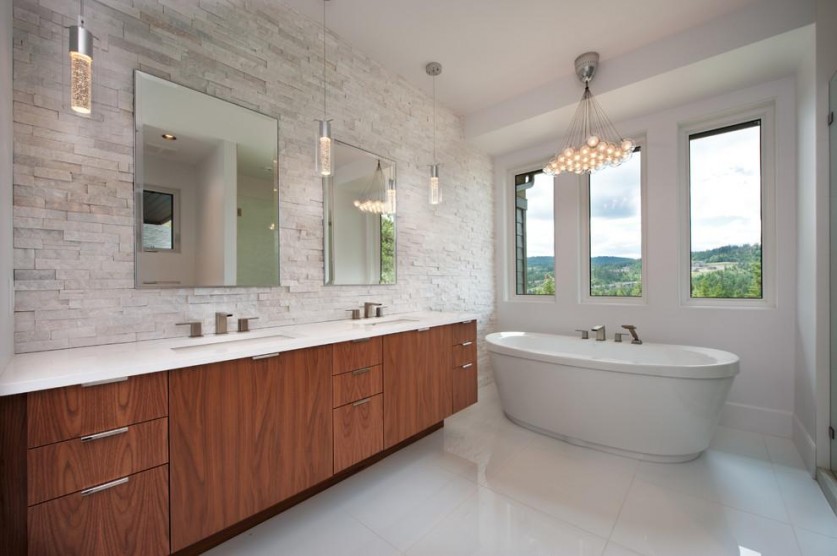
Material is the key to success! How to choose a stone if you are not a pro
The question immediately arises: what stone is better to use for interior decoration? After all, the market building materials today offers:
- natural stone;
- artificial stone;
- decorative plaster and other stone-like materials.
Let’s look at each type, as they say, “stone by stone.” We will evaluate it in three categories: aesthetics, practicality, price.

1. Natural stone
The most common breeds for interior design conditionally divided into groups:
- sedimentary (limestones, sandstones, travertines);
- metamorphic (marble, quartzite, schist);
- volcanic or igneous (granites, tuffs).
Favorite breeds for interior decoration- sandstone, travertines, slates and marble, although, of course, there are many options.
Beauty
Most organic natural material, which has been used for decoration for centuries. Natural stone has a complex, individual texture and unique color scheme. Ideal for spacious interiors, used for cladding fireplaces, columns, accent walls. If you live in a small apartment, use stone as a floor finish.
Life hack: save on other finishing materials, but make the floor out of natural stone - the room will immediately look expensive, but not chic.
What to consider
It is worth considering that laying a natural stone floor is best done during the construction process. Wall cladding also poses a number of requirements.
- The thickness of the stone should not exceed 30 mm.
- When facing a wall with sandstone, it is important that the surface is made of a related material (concrete, brick, foam concrete, aerated concrete).
- Cladding surfaces with a height of more than 1.5 m requires additional fastenings to the load-bearing surface with hooks, screws, and dowels.
- If the base for the stone is not uniform, then a masonry mesh is attached to the surface.
Price issue
Natural processed stone is certainly beautiful, but it is expensive. To reduce its cost and simplify the installation process, sawn stone, unedged stone, “noodles” from natural stone and a strip. When estimating how much such repairs will cost you, remember the costs of delivering the material, as well as its installation - all this is not cheap.
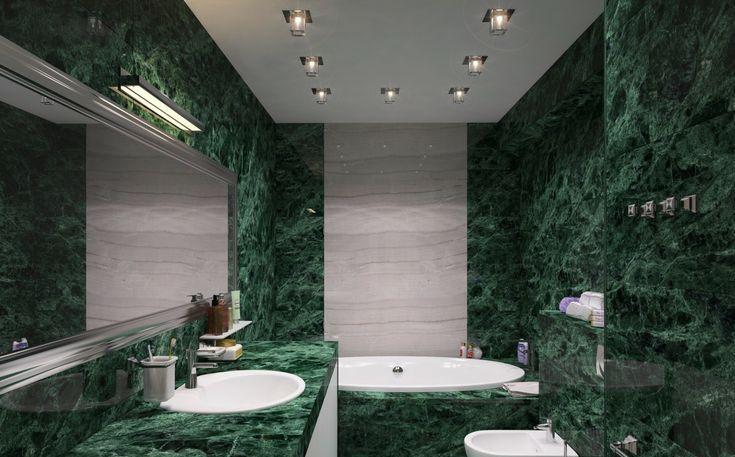
2. Artificial stone
There is no money for natural stone, we use artificial stone. Mainly 3 types of artificial stone are used: glued stone chips or “flour” with additives, “stone-like” concrete and acrylic. In fact, these are materials that only imitate stone. Sometimes it's cheaper, but more often it's just easier to use in small spaces.
Beauty
Artificial stone is beautiful because it can completely imitate the surface of natural stone, or it can look completely different and more interesting from a design point of view. Artificial options make it possible to obtain materials that are not afraid of moisture and fungus, and are more durable. Monolithic countertops in the kitchen with built-in sinks - few natural stones can replace the possibilities of “fake” here.
Artificial stone in design allows the designer to think more broadly. They can be used to line walls, niches, create wall decor elements, decorate a wide variety of furniture, make window sills, bath bowls, and anything else.
What to consider
It is believed that laying artificial stone requires less time and effort. Yes, installation in this case is easier, but it requires skills in “tile” laying, perfectly smooth walls and a strong adhesive base. Often, when choosing artificial stone as an interior material, customers do not take into account important aspects.
- Artificial stone tiles are quite heavy. One square meter of coating can weigh from 10 to 90(!) kg. It’s clear: the greater the relief and strength, the greater the weight.
- The porosity, density and other characteristics of artificial stone are not suitable for conventional ceramic tile adhesive. To cover walls with this material, special adhesive mixtures are required.
- Naturally, you cannot glue artificial stone to wallpaper, paint, or film. And for cladding stoves and fireplaces, a special heat-resistant base is required.
- Dismantling stone tiles is a costly undertaking. In essence, this is “masonry” that will later have to be knocked down with a hammer drill.
Price issue
Do you think artificial stone is cheaper than natural stone? Only manufacturers promise this, but in reality it is often not so accessible. High-quality aesthetic versions of acrylic can cost even more than the natural “original”, but yes, they are comfortable to use.
When estimating the costs of artificial stone, do not forget to include in the estimate the material for laying it and cement mixtures for leveling the surfaces.
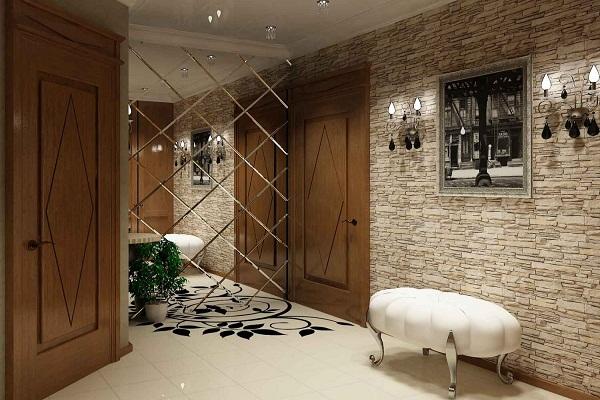
3. Decorative plaster “like a stone”
“Plaster is not stone,” you say. But the previous option, the artificial stone, also “didn’t lie nearby.” Its resemblance to natural is emphasized in appearance and similarity in styling.
How about a material that allows you to easily create a stone surface on the wall? Even with your own hands, without masters, and if with a master, then without a round bill for the work. Without hassle when transporting the material, when, God forbid, it gets scratched or chipped. And not only on the wall: after all, there are decorative coatings that can be used for floors or, for example, for furniture surfaces.
Decorative plaster allows you to create a uniform, beautiful surface of the stone, while:
- Does not have ugly seams or joints.
- Due to the comparative lightness of the plaster, even a plasterboard wall can withstand such a “stone”.
- It is safe for health, consists mainly of natural materials and is environmentally friendly.
Moreover, the composition of decorative plaster is similar to artificial stone: for example, in the photo below the wall is covered with Loggia plaster.

Beauty
In a city apartment, “decorative” is the most practical and convenient design option. Using this material, you can recreate any surface: smooth or rough, matte or glossy... To depict the surface of various types of stone, texture-forming tools are used, as well as glazing compounds that create gloss or tint, shade the “stone”.
Stone chips or “flour” of marble, granite, tuff, limestone are used as fillers for plasters, and mica is added to the composition for natural shine. As a result, not only the color and pattern of the stone and its beautiful veins are recreated, but even the texture of the stone after chipping. If desired, you can make a surface that cannot be distinguished from natural stone panels. If you want to show your imagination, you can create a completely cosmic stone, say, marble with lilac mother-of-pearl tints - after all, everything is possible here!
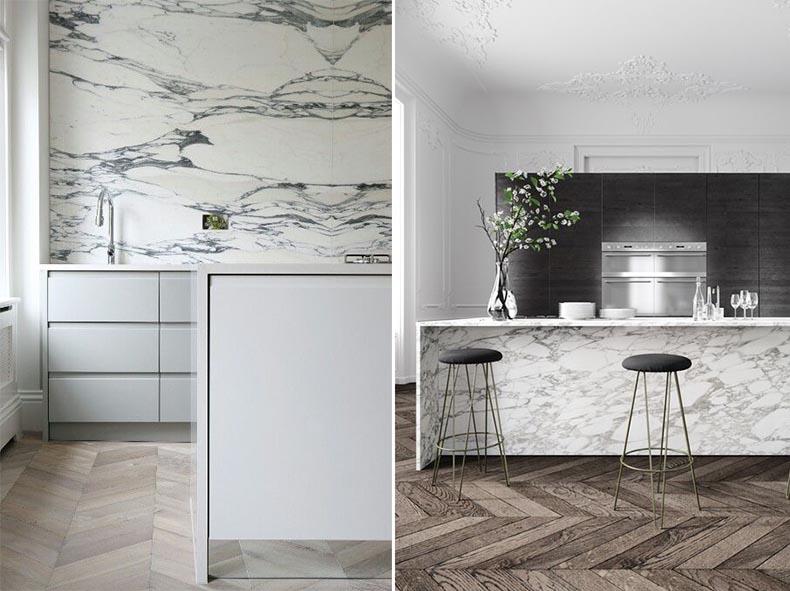
What to consider
The difficulty of working with decorative plaster depends on the effect you want to achieve; sometimes you really need a professional to apply it. But most of the “stone” effects are applied very simply: you can easily create a travertine or sandstone surface by reading the instructions and watching a short video.
- For many types of stone-like plaster, costly preliminary leveling of the walls is not required.
- The maximum weight of a square meter of coating reaches 5 kg, and this allows the coating to be used on relatively weak-bearing structures.
- Plaster is not so demanding on the surface of the walls, individual species easy to apply to almost any material (for example, Plasma 3D, which is applied directly to tiles or laminate without any surface preparation).
Price issue
This is at the beginning of the two thousandth decorative plasters were expensive. Look at the prices of Italian brands today: a square meter of coverage from the European manufacturer Loggia is now at the same level as good wallpaper.

Decorating walls with stone: it's simple!
If you understand the intricacies of working with “stone” surfaces, recreating a fashionable eco-interior from the cover of design magazines is not so difficult. After all, you can live in style regardless of the size of your apartment!
Mar 12, 2017 Sergey
One wall made of stone - creating a daring interior
Many people note the attractive power and magic of this material, trying to use it to give the room originality and magic. You can use stone to decorate a kitchen, living room, bathroom, balconies, bedrooms and even a nursery (most often it is one wall made of stone). In our article we will tell you how to create the daring interior of your dreams easily and simply!
Types of artificial stone and combination of materials.
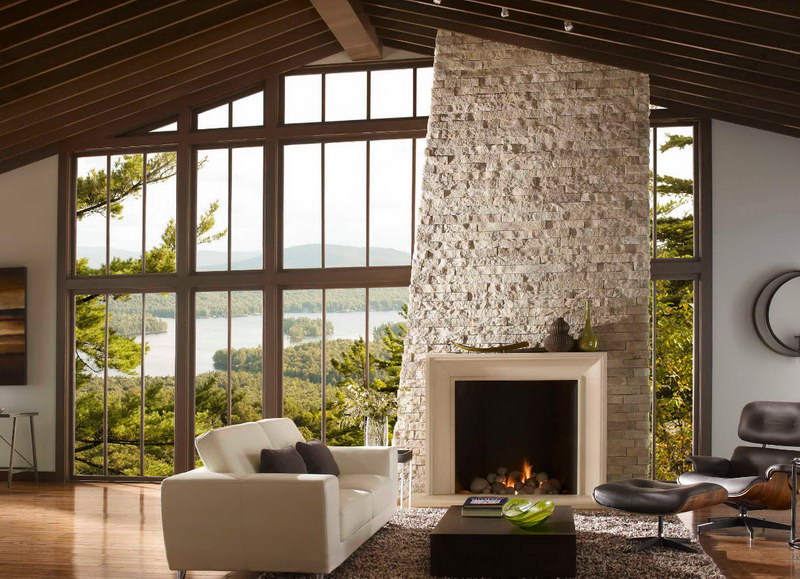
Today there are 3 types of stone:
- porcelain stoneware;
- concrete-based stone;
- agglomerate.
Cost-effective and popular is artificial stone based on concrete, which is distinguished by a variety of decorative possibilities, ease of installation and further care. Modern technologies production allows us to obtain stones of various textures, which in appearance are almost impossible to distinguish from natural stone.
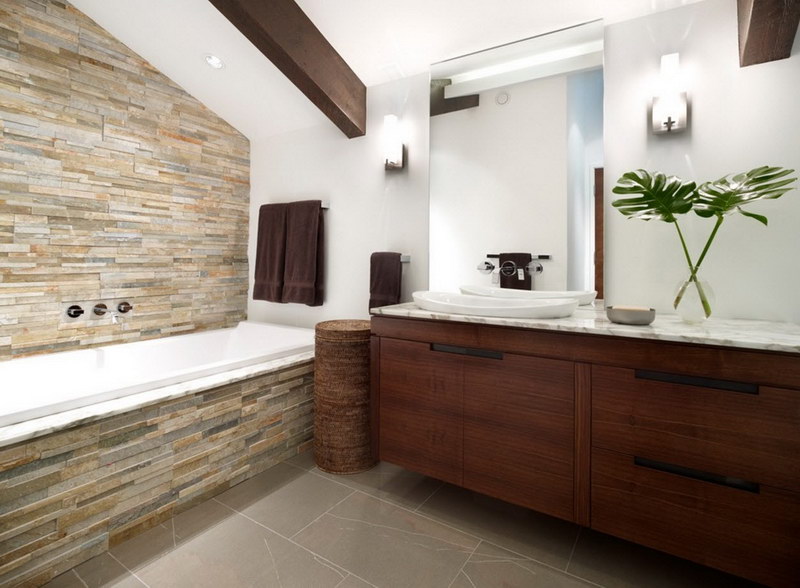
Artificial stone has a number of advantages:
- durability;
- strength;
- environmental friendliness;
- safety.
If you follow the rules for installing artificial stone, this decor will serve you for decades; it can withstand the strongest mechanical loads. As for safety, it should be noted first of all the fireproof characteristics of this material, as well as safety for humans (non-toxic compounds are used during production).
The harmonious combination of stone with wood, glass and metal makes this material one of the most versatile and in demand.
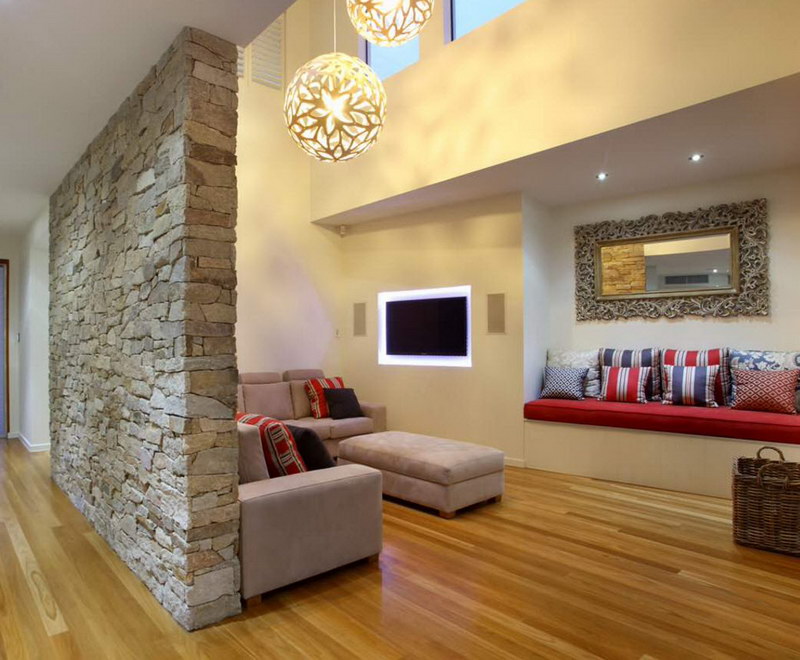
Decor options - one wall made of stone
The most common option is to decorate one wall of the room. Thus, you can highlight any element of the apartment by placing things and interior items that are dear to your heart. It should be noted that the use of this technique allows not only to create a daring interior, but also to visually increase the area of the room.
You can use stone to create an original panel or pattern that will give your room a unique style and make it more cozy and comfortable. A win-win option is to decorate with stone under brickwork. This finishing material will look natural in kitchens, hallways, living rooms, libraries, meeting rooms and work rooms.
An important role is also played by the fact that the finishing stone has a small thickness, which guarantees the preservation of such an important space in our apartments.
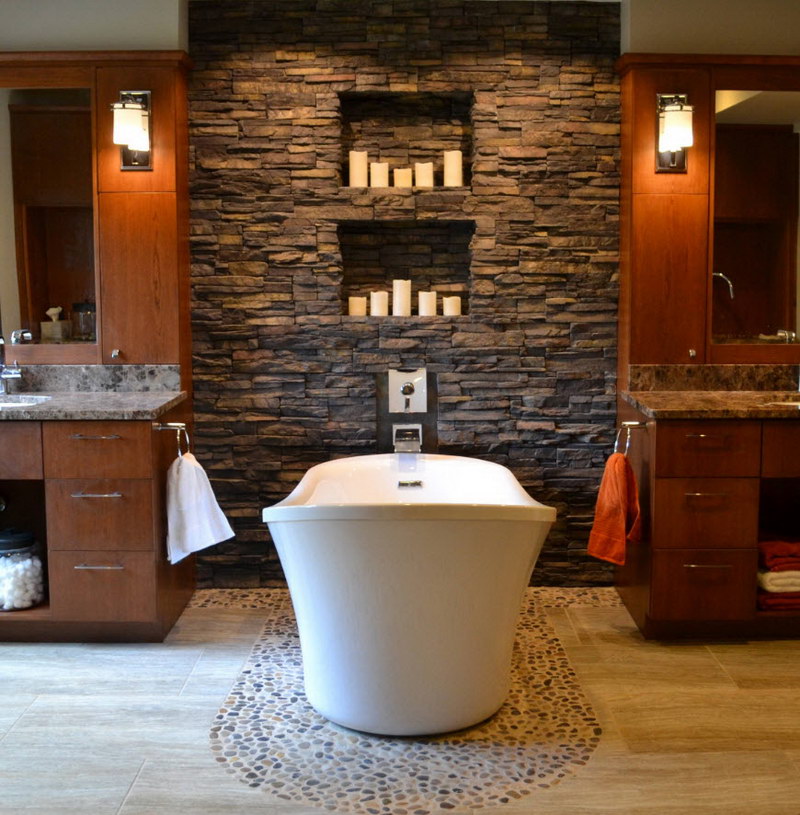
One wall made of stone - decor rules
When planning decoration with artificial stone, you need to remember some nuances.
- Artificial stone reduces the lighting of the room (even light-colored stone). Consider adding additional lighting.
- When installing dark stone, remember to alternate it with finishing materials light colors (wallpaper, plaster or artificial stone).
- If the room being decorated has a small area, designers do not recommend getting carried away with artificial stone and covering an entire wall with it.
- To give the interior a lively coziness and warmth, use living plants.
Installation of artificial stone depends on the thickness of the material, as well as the design of the wall. As with wallpapering, the surface of the wall decorated with stone must be perfectly flat, plastered and primed.
To glue the stone, a special glue is used, which a consultant at a hardware store will help you choose.

Stone in the interior
Living room. The use of artificial stone will give the room volume, texture and boldness, which can be softened with wooden inserts, paintings and decorative inserts.
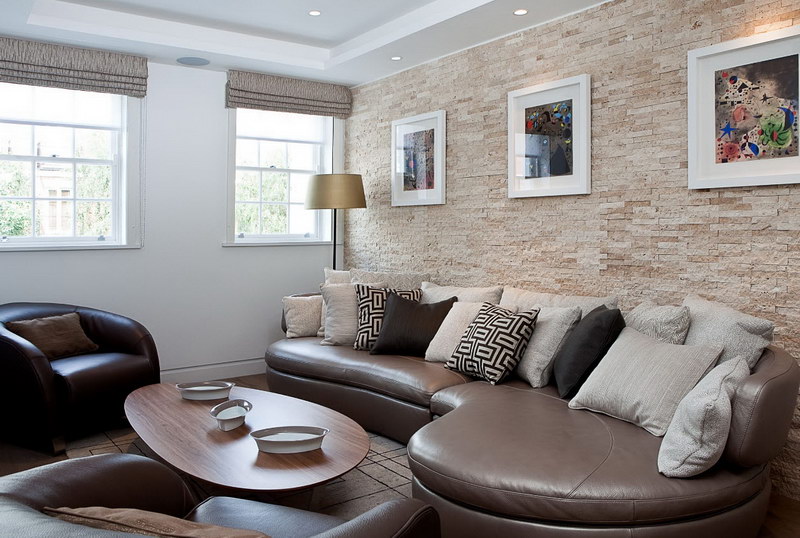
Kitchen. Most often, in this room, an apron in the work area is decorated with artificial stone. It is important to remember the combination of textures and colors. Stonework will help create an unusual, but at the same time harmonious and comfortable interior of the room.
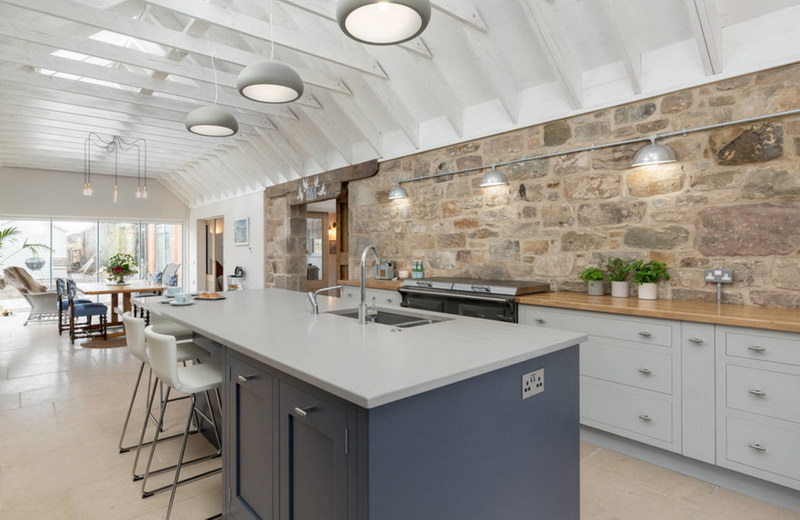
Bedroom. Artificial stone is used to decorate the wall at the head of the bed. Properly selected materials will allow you to create a sophisticated and elegant bedroom interior, emphasizing its main purpose.
Children's room. In this case, artificial stone is used as a decorative detail, with the help of which emphasis is placed on small details. It is not recommended to get carried away with stone in a children's room, otherwise you risk turning your child's room into a hobbit's bedroom.
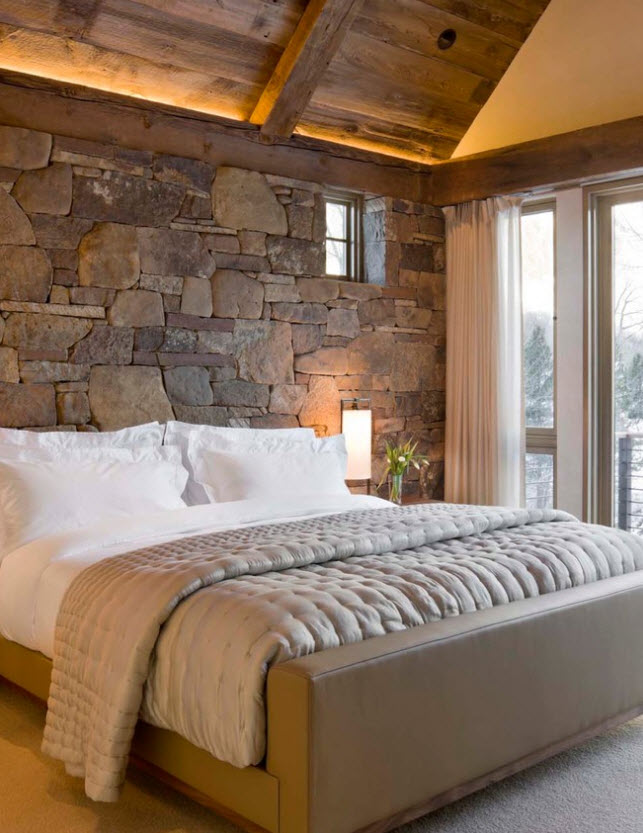
Bathroom. Stone should also be used with caution in small bathrooms. In this case, the rule of allocating a certain small area of the room is also relevant, thus creating an elegant and royal interior.
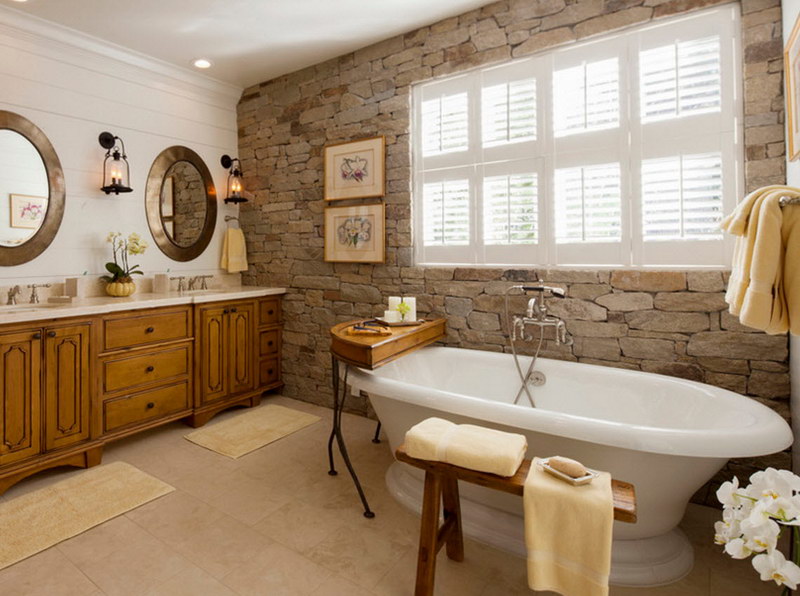
One wall made of stone - photo


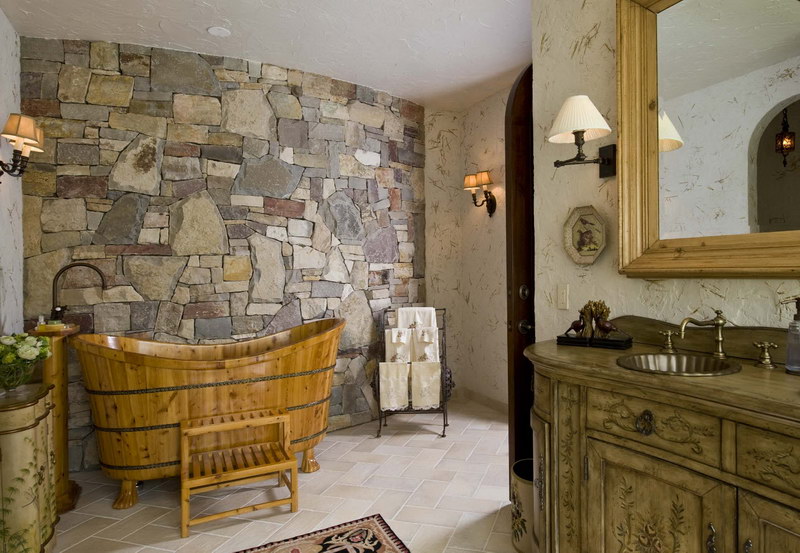
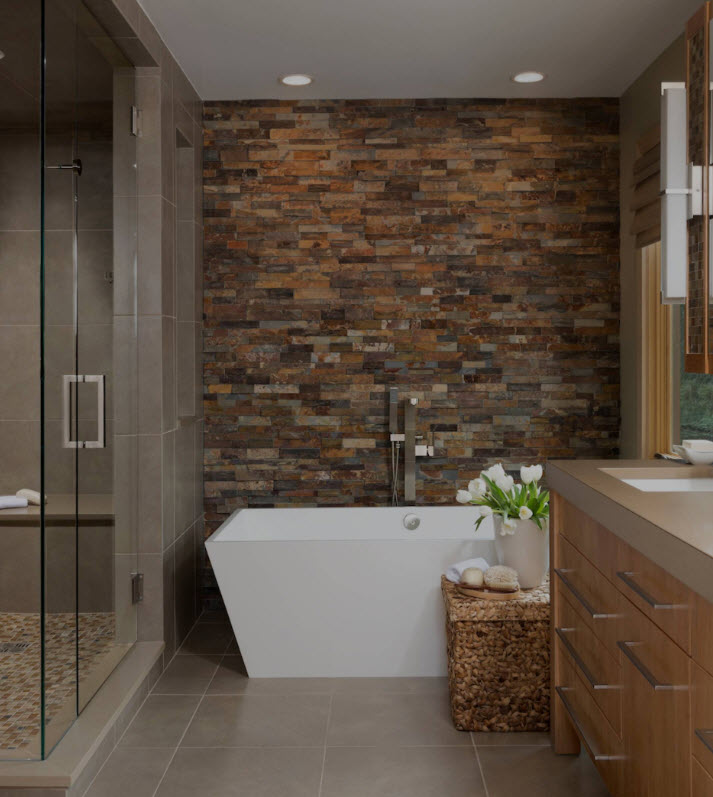
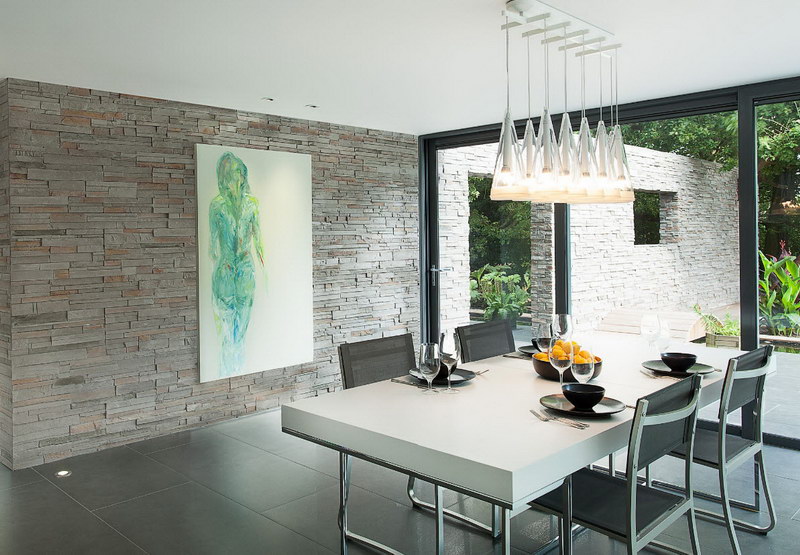
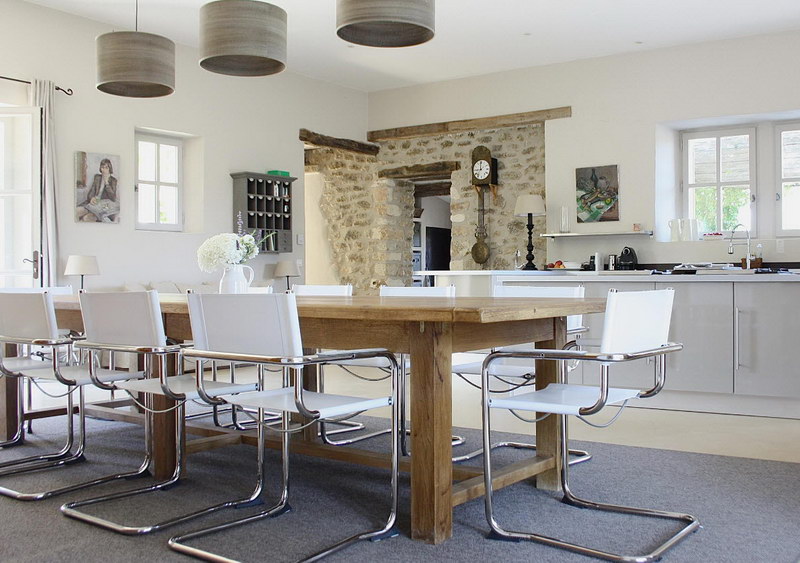
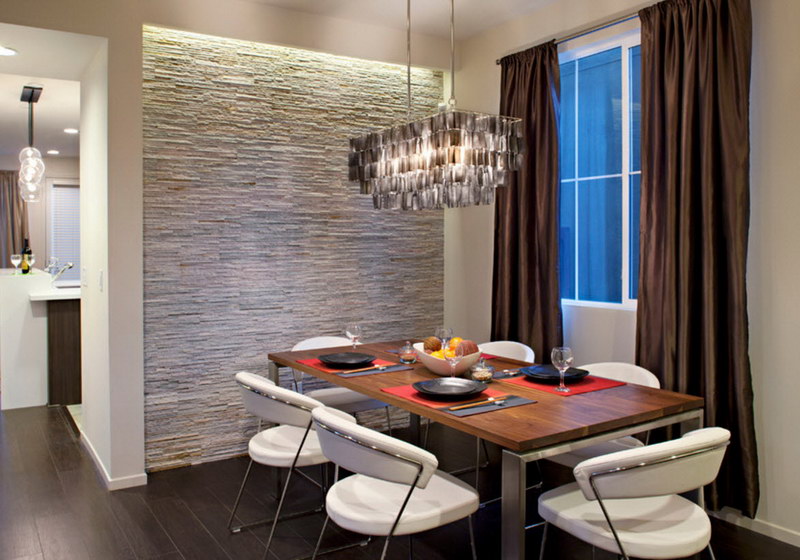
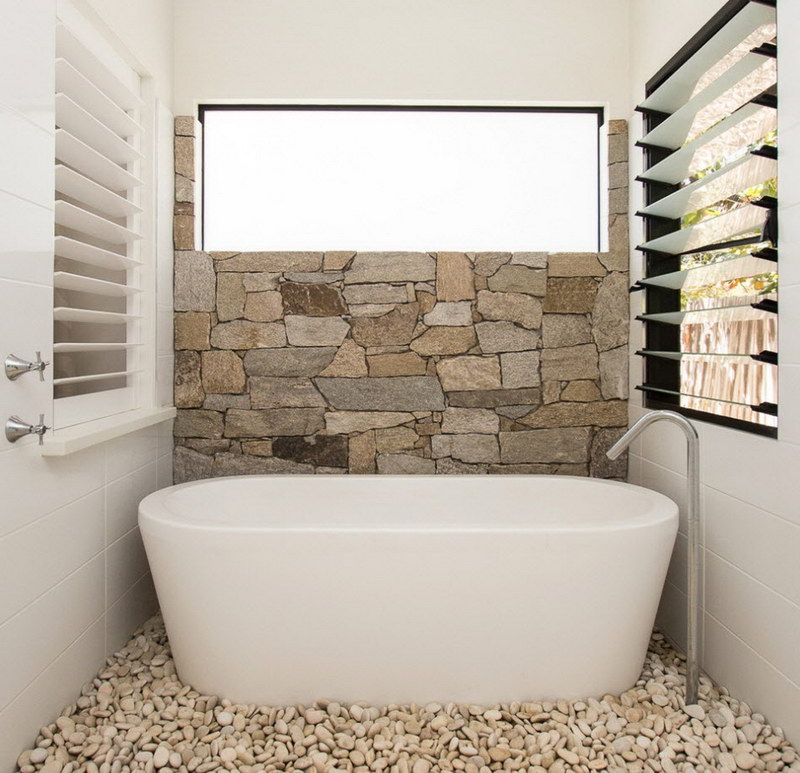
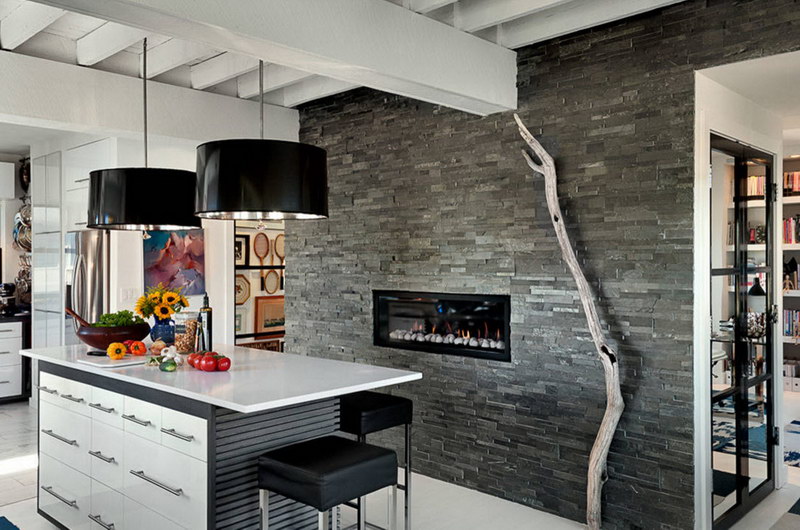


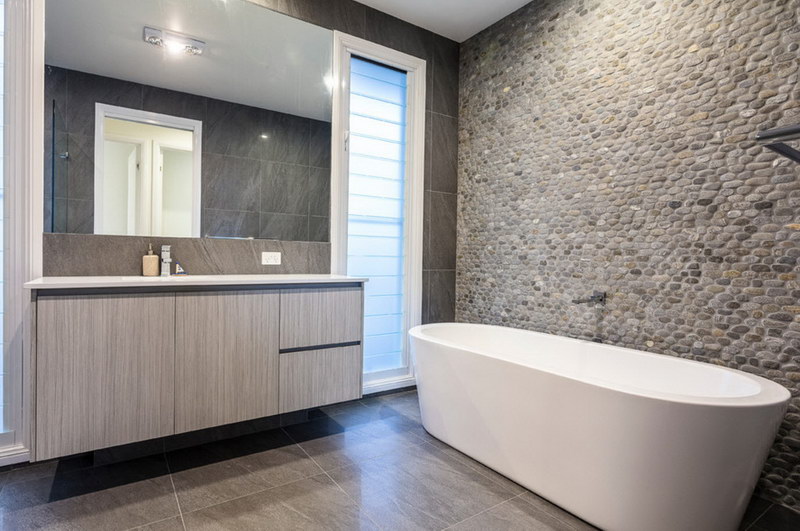
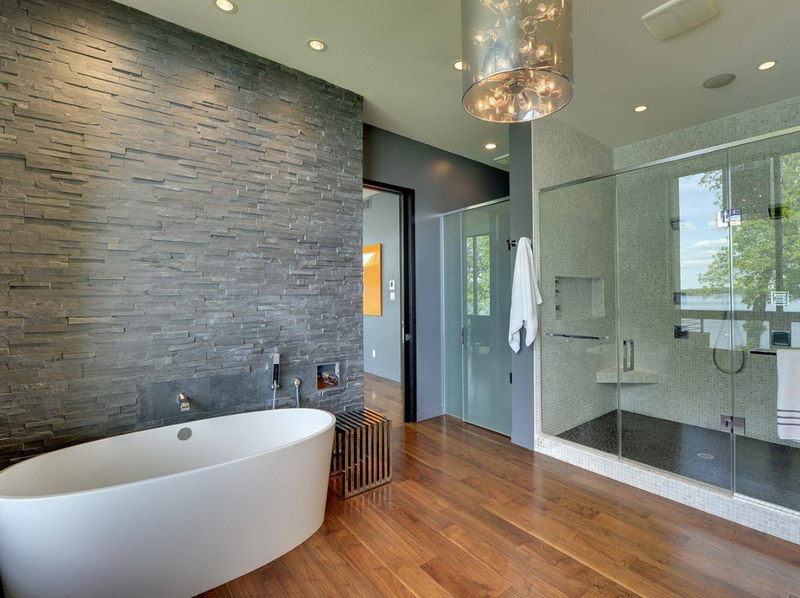
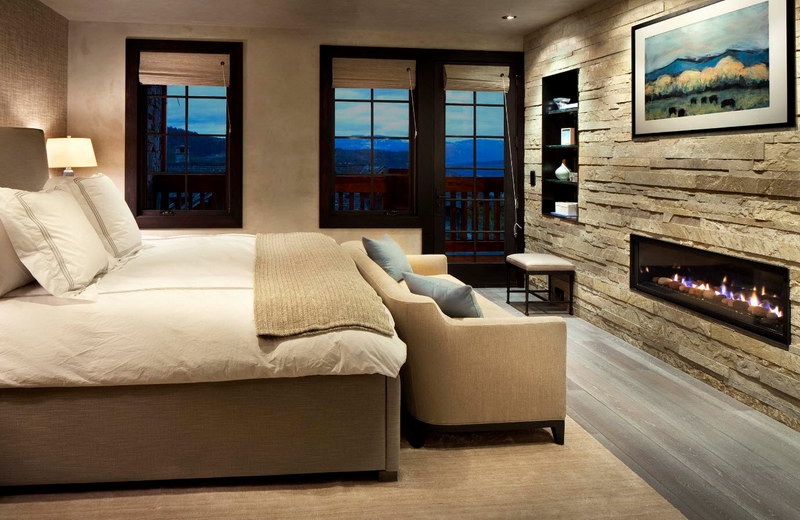

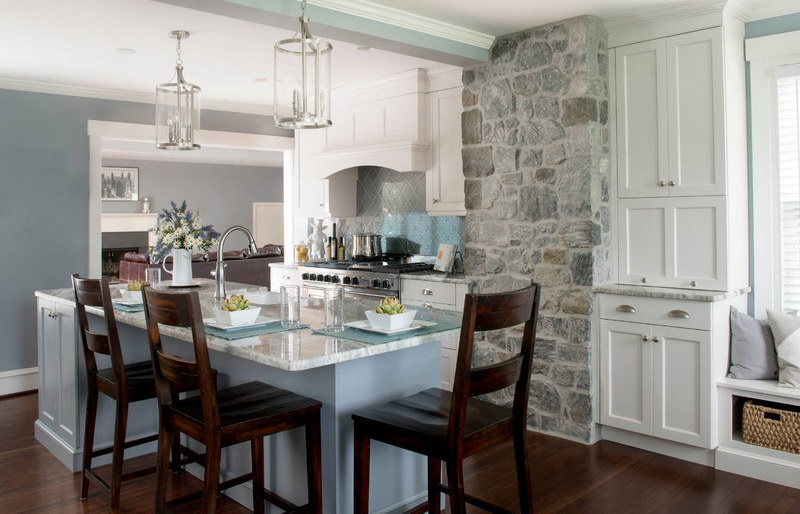
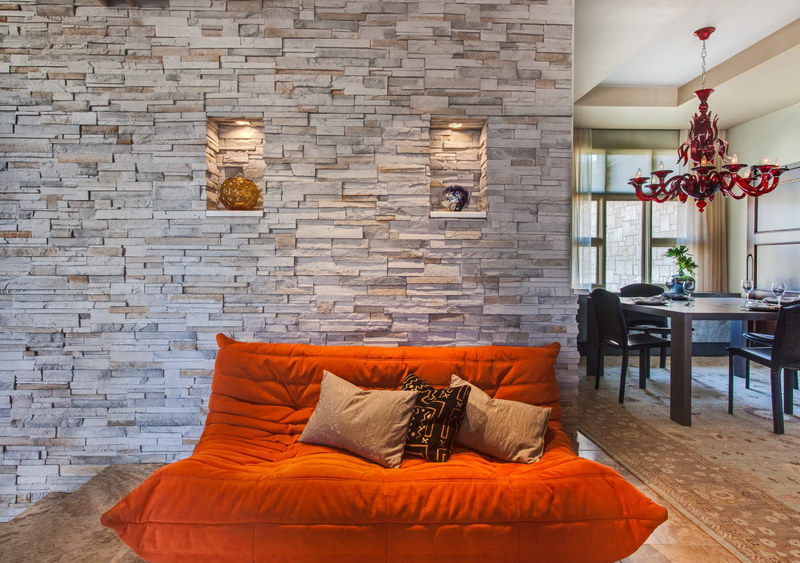
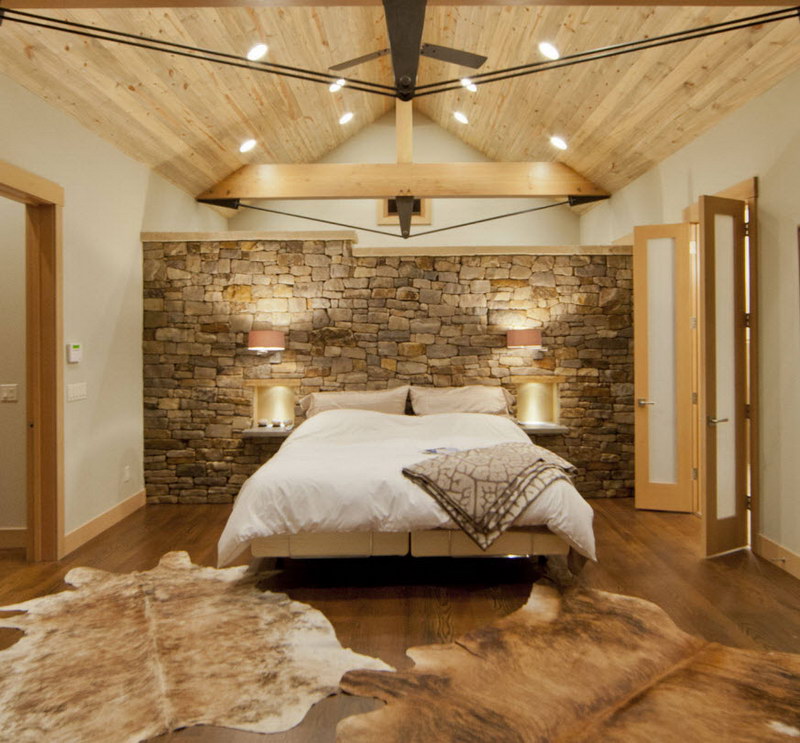
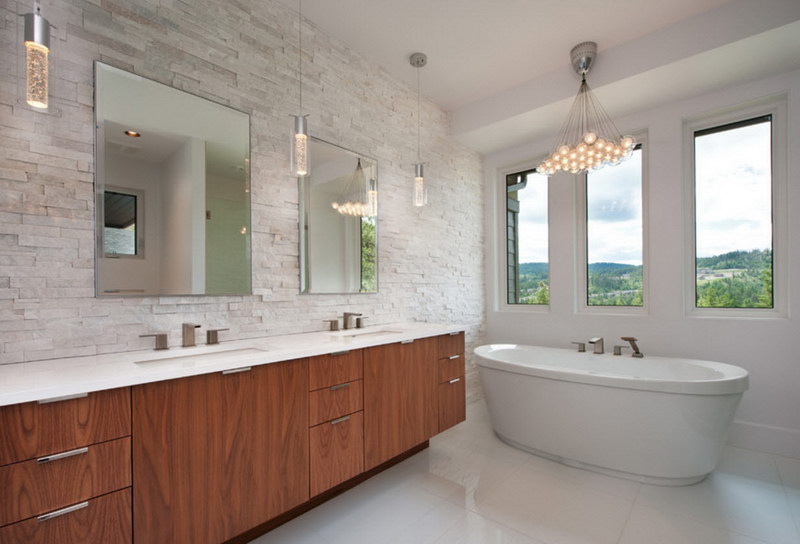
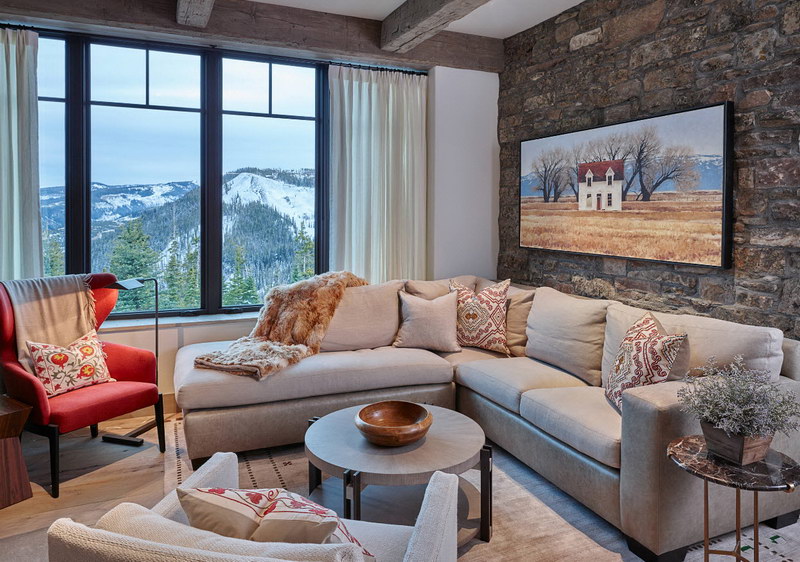

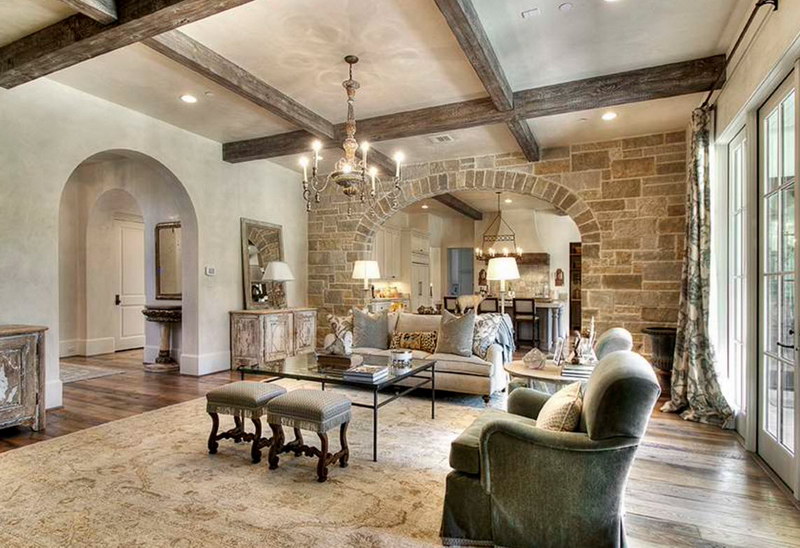
![]()
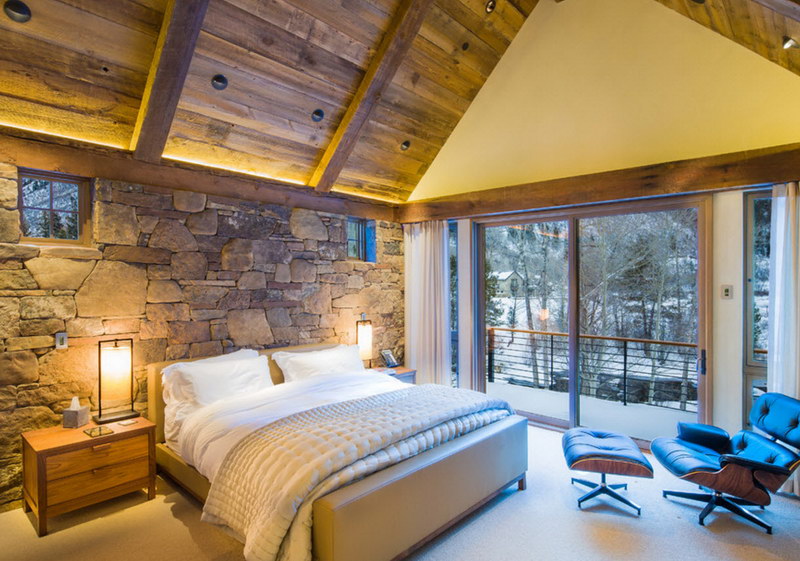

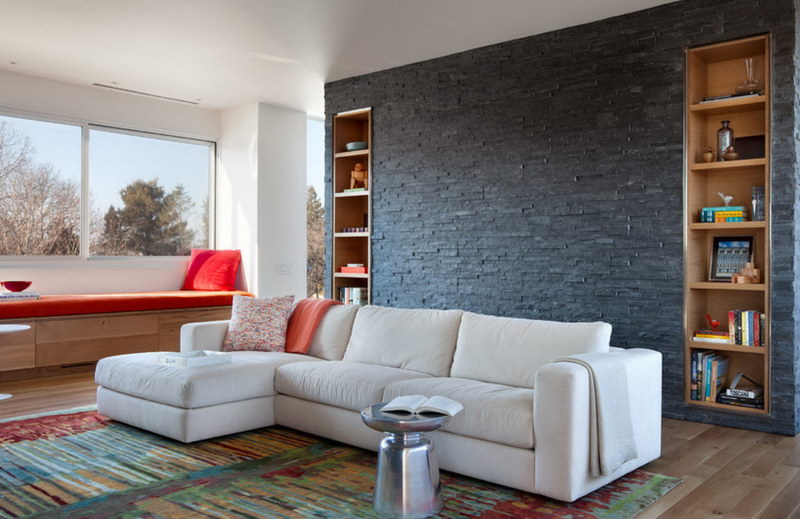
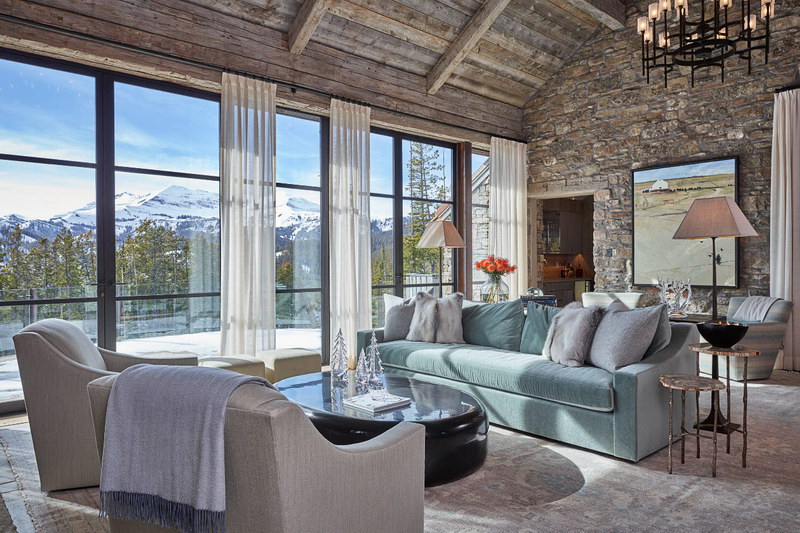
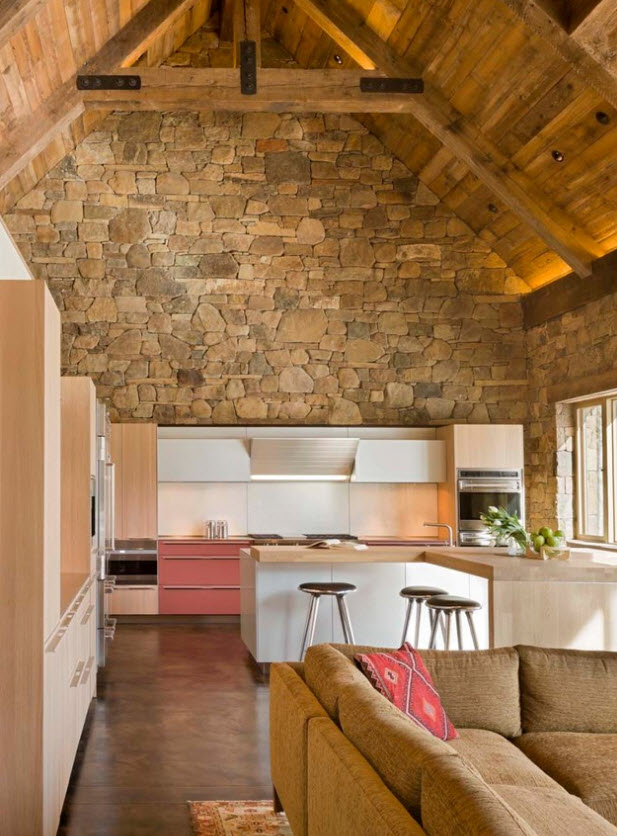
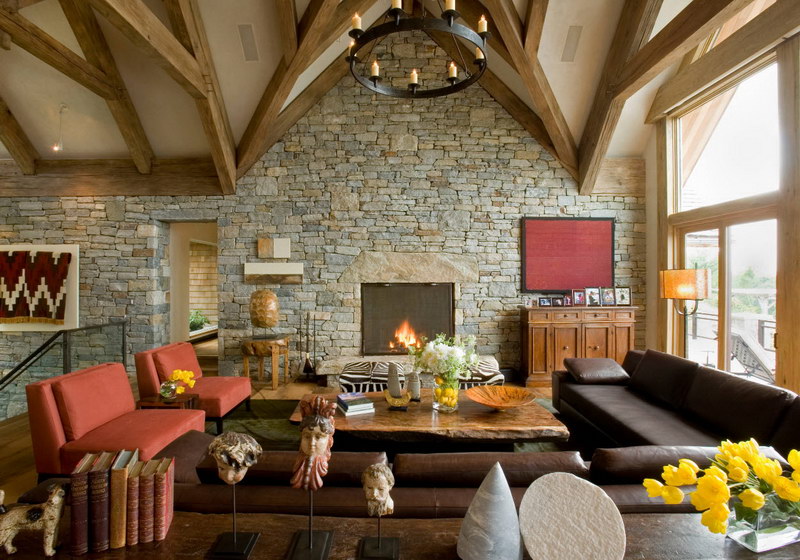
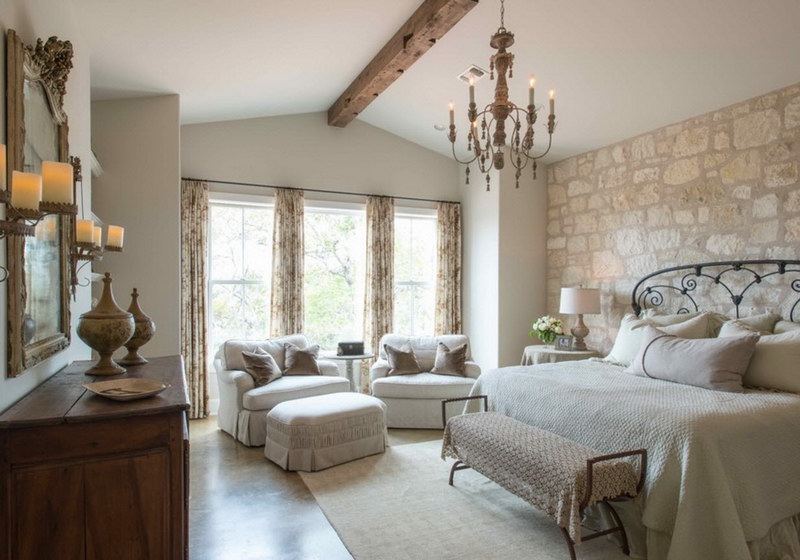


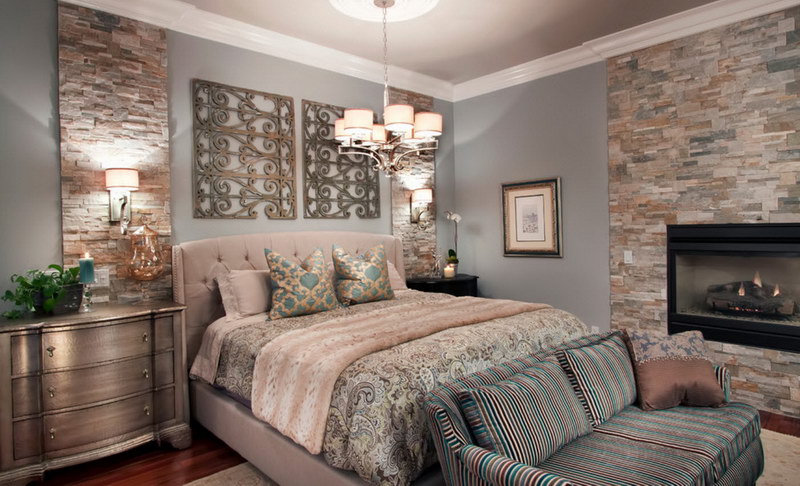
![]()
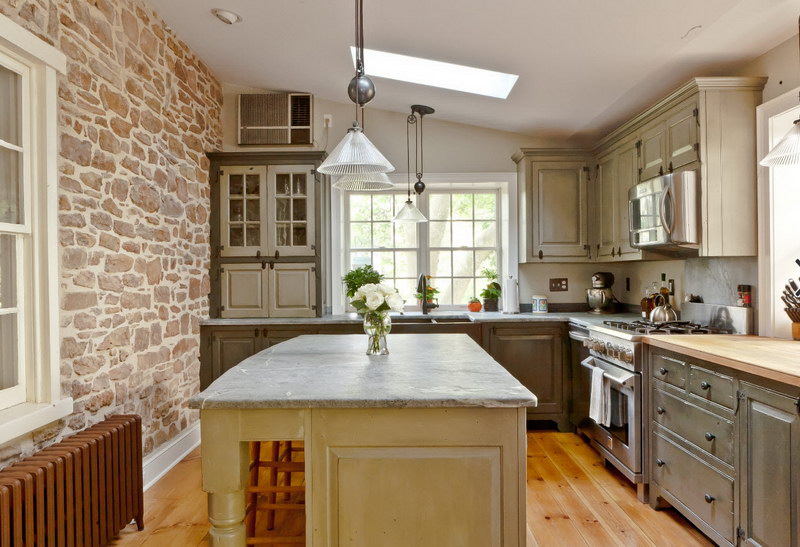
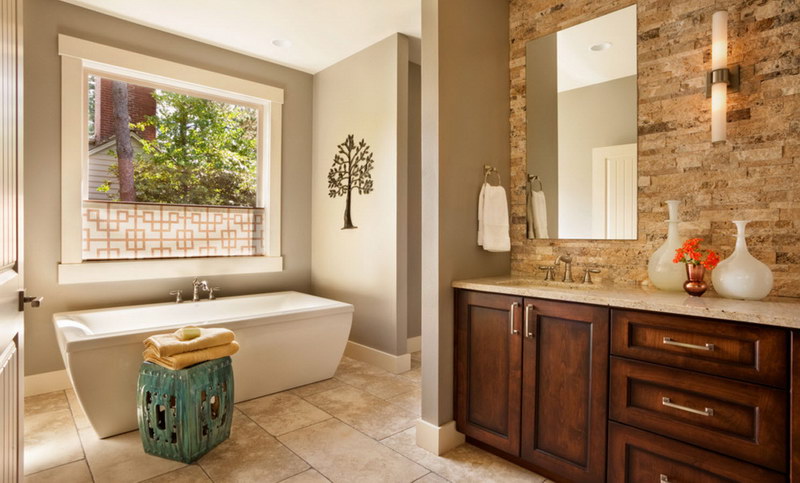
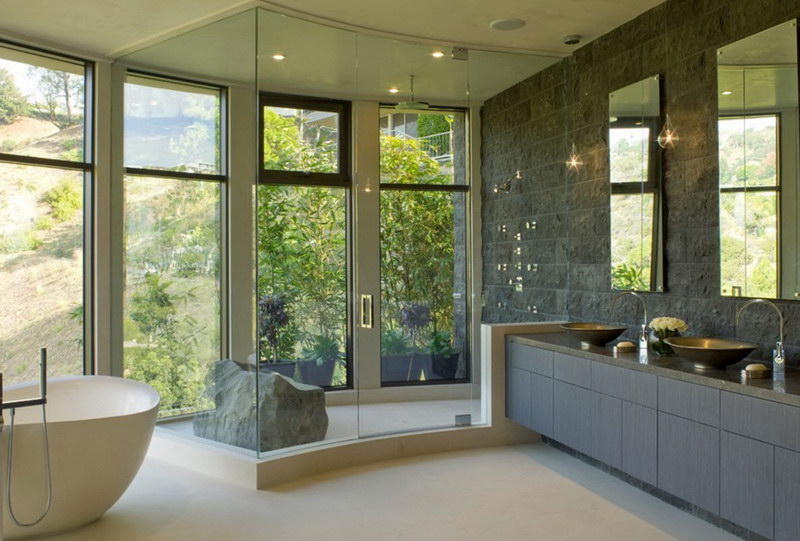
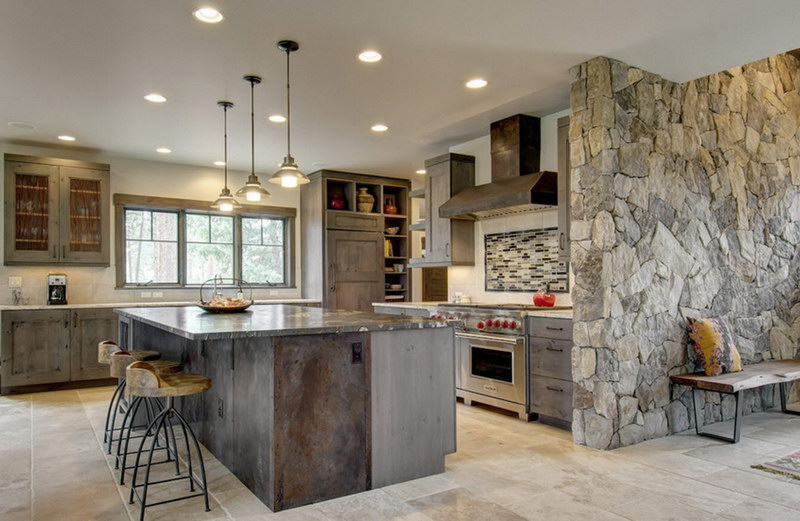
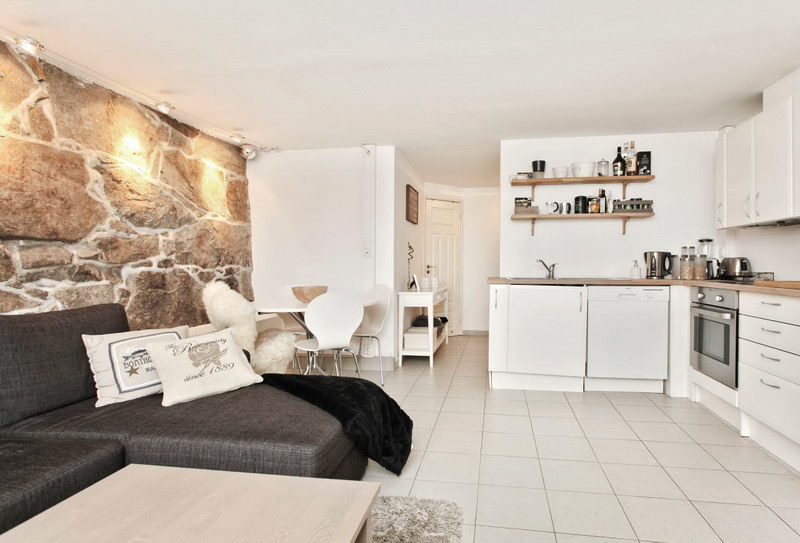
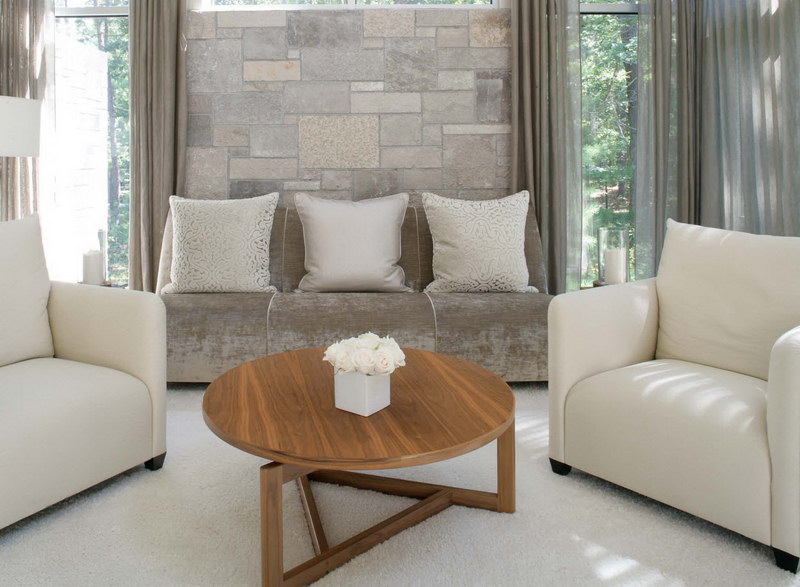
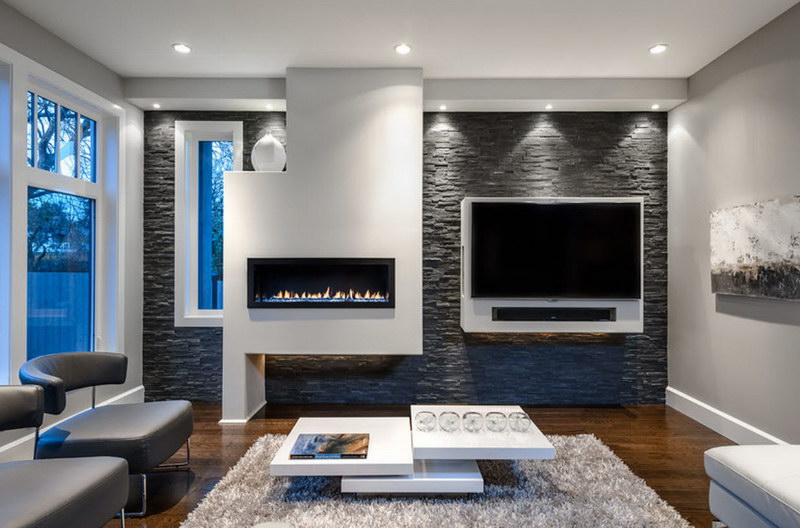
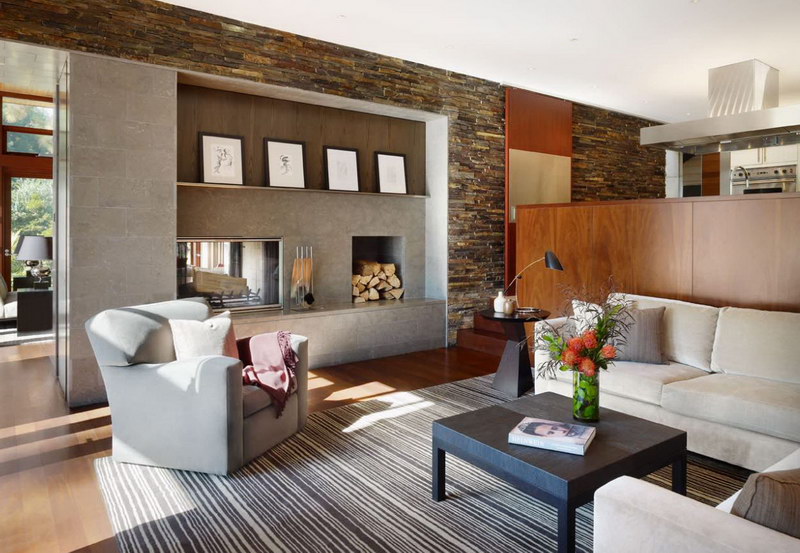
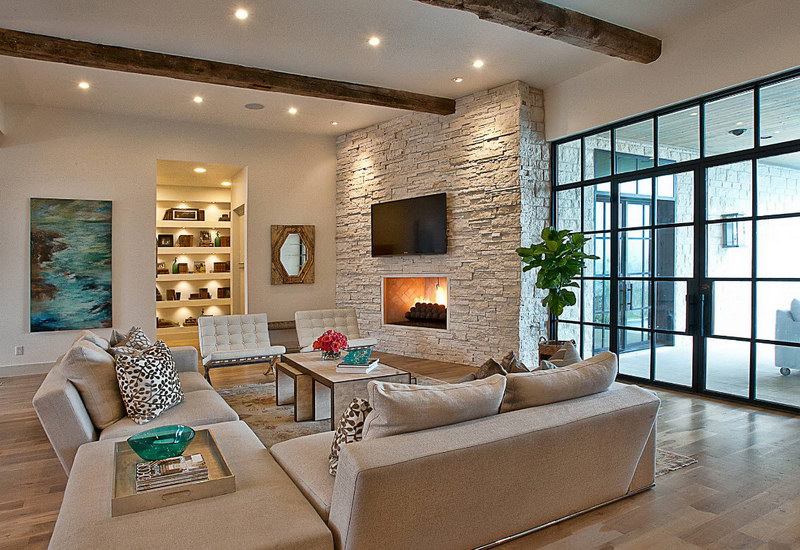
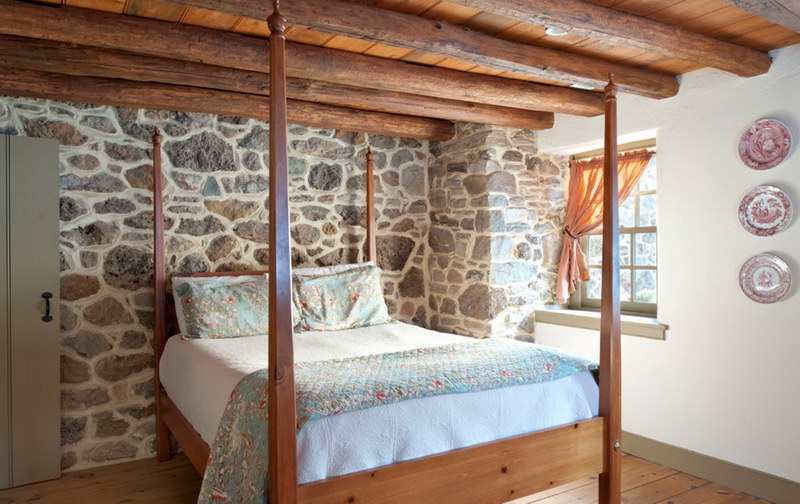
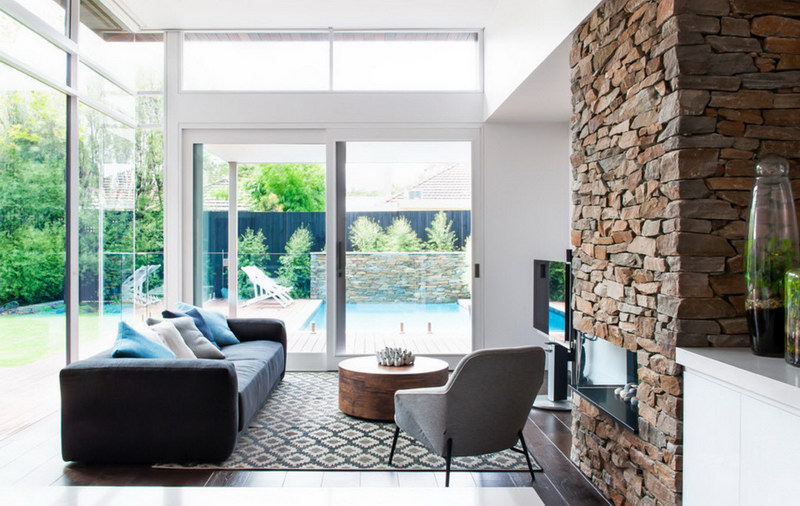
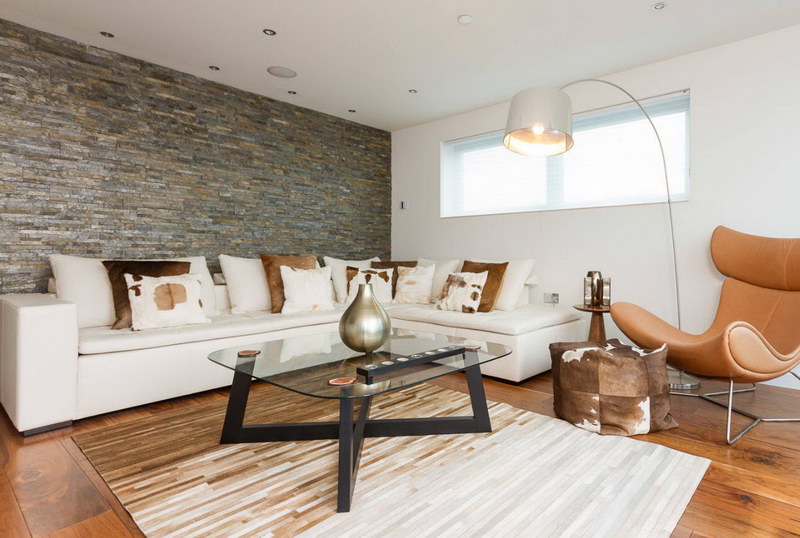



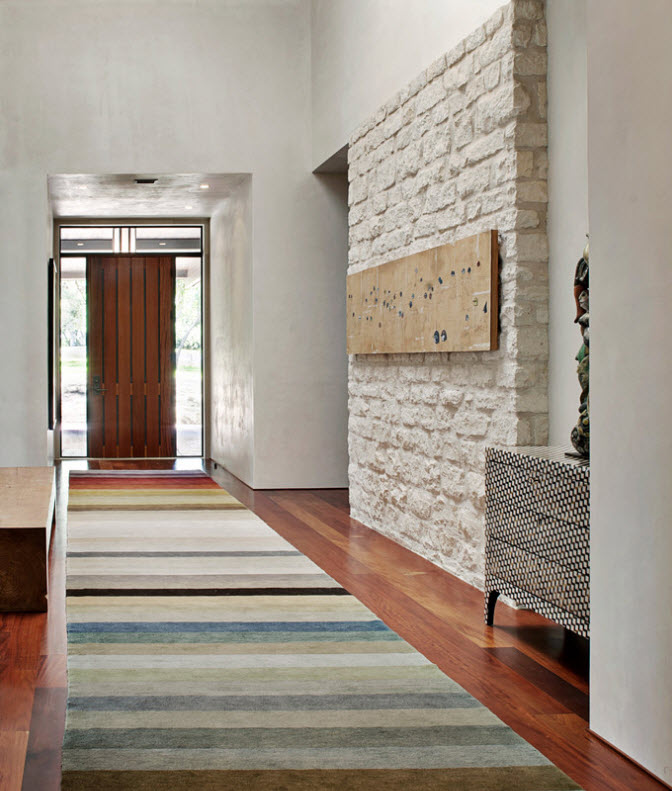
![]()
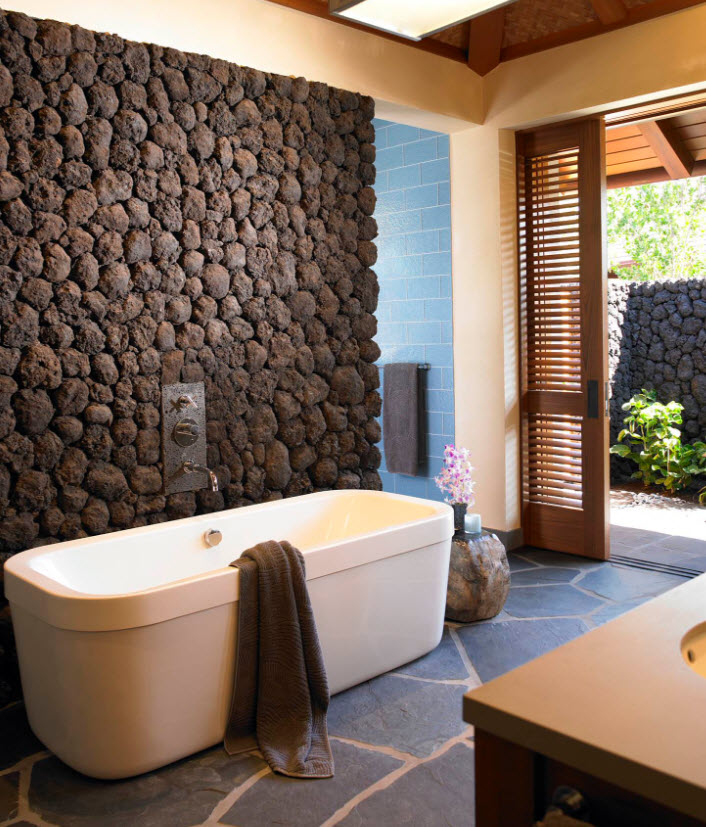
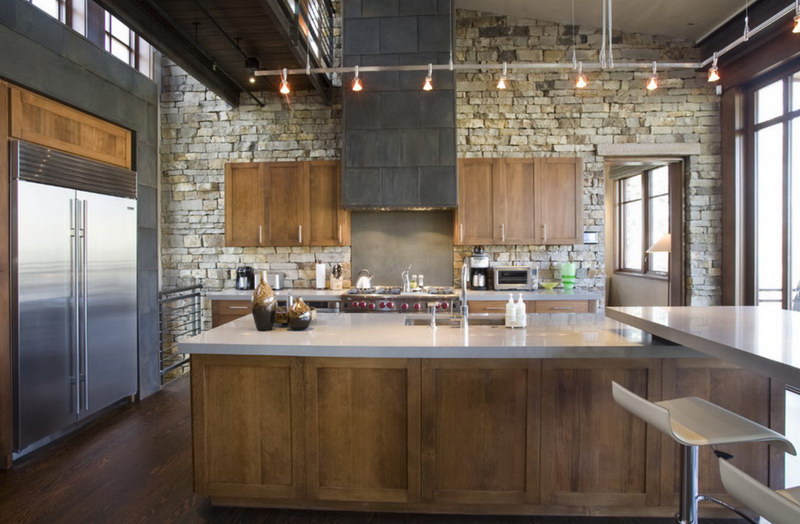
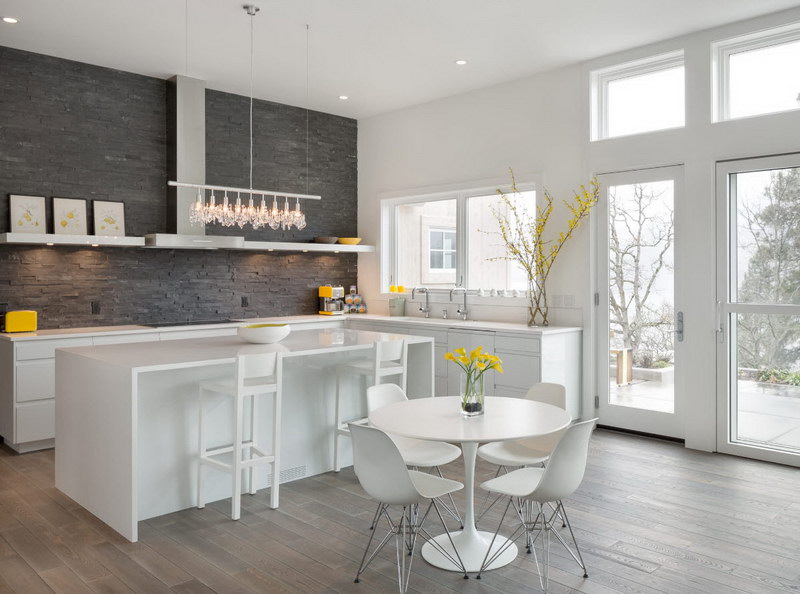
Decorative stone in the interior of the apartment helps to create a feeling of sophistication.
Different textures, shapes, and colors allow you to include this element in the design of any room: corridor, kitchen, living room, bathroom.
Since ancient times, wealthy people have decorated their homes with granite, marble and other natural stones.
But due to the high cost, exhaustibility and heaviness of natural materials, they were successfully replaced by artificial ones.
Using concrete, sand and various dyes, craftsmen create masterpieces - stones that do not differ in appearance from their natural counterparts.
Advantages of decorative stones
- is environmentally friendly and does not contain harmful impurities material;
- resistant to corrosion, mold and fungi;
- easy to care for;
- thanks to all sorts of shades and textures, it provides unlimited scope for design solutions;
- easy to install;
- has strength, heat resistance and frost resistance;
- has a low cost.
Designers note that decorative stone is becoming increasingly popular in apartment interiors (especially for the hallway and kitchen).
If previously it was fashionable to cover only the fireplace in the living room, now this element is used in all rooms of the apartment.
Hallway
The first impression of your home is made by the appearance of the hallway/corridor.
Decorative stone in the interior of the hallway will allow you to judge the sophistication of its owner’s taste right from the threshold.
When, one should take into account its relatively small size and lack of natural light.
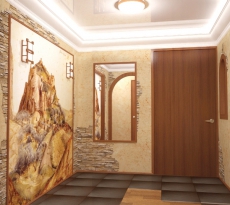
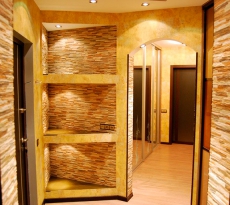
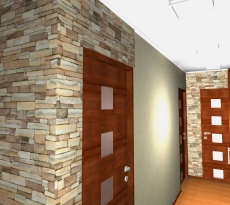
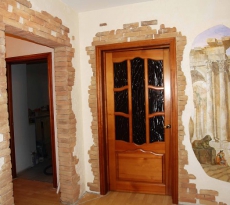
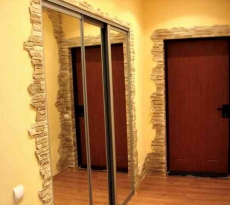

Therefore, when creating a background, it is better to give preference to light colors.
If you like dark shades, then use additional lamps to avoid a gloomy effect.
The optimal solution would be partial finishing.
For example, cladding part of a corridor wall or doorway would look great.
The wall behind the hanger, trimmed with decorative stone, will not only look elegant, but will also be protected from friction by clothing.
A mirror decorated with light materials ennobles the interior of the corridor and visually increases the space of the room.
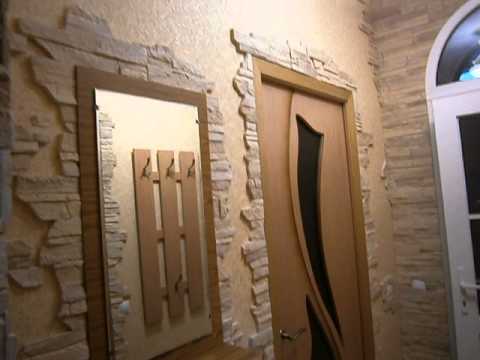
If the rooms of your apartment are separated from the corridor by an arch, then use decorative attributes to highlight the arched passage.
When decorating a corridor, avoid oversaturation, otherwise, instead of sophistication, the room will give the impression of being burdened.
Living room
Lush receptions and cozy family gatherings take place in the living room.
Most often, this part of the apartment is the largest in area.
Therefore, decorative stone in the living room interior is used to highlight different zones.
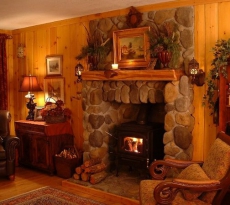
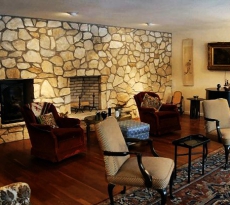
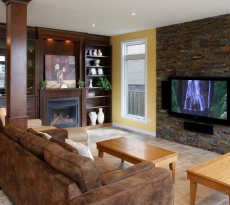
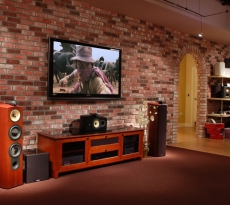
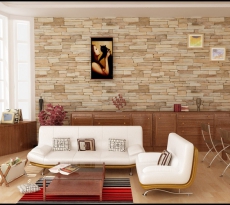
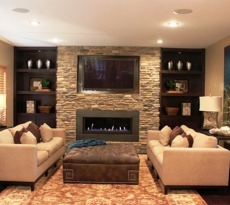
A wall near the dining table with a stone finish will create a feeling of comfort and solemnity, turning ordinary meals into feasts.
The shelving area, emphasized by decorative stone, will attract attention.
The figurines and other decorative elements placed on the rack will sparkle with new colors, surrounded by rich stone decoration.
The heat resistance of this material allows you to cover the fireplace, creating an even more cozy atmosphere around the hearth in the living room.
Can also be finished small area in front of the fireplace.
The bar counter, popular in modern homes, is increasingly covered with decorative stone.
A stand for glasses and a niche with bottles of wine, in this design, will add aristocracy to the bar area.
In the same way, you can highlight a relaxation area in the living room by decorating the area near the TV, armchairs and sofa.
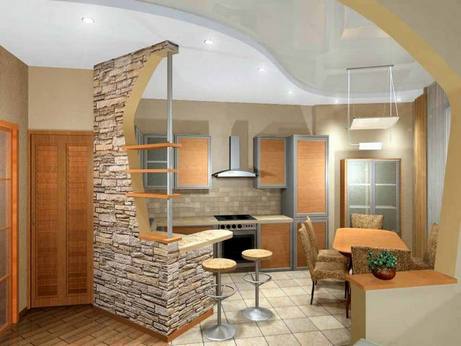
Diversity color range decorative stone will allow you to use smooth color transitions or contrasting accents to give a unique style to your living room.
Kitchen
The use of decorative stone for the kitchen interior found its application relatively recently, but was immediately loved by both designers and owners.
Even a tiny kitchen can be transformed beyond recognition.
In addition, the practicality of decorative stone is ideal for the kitchen.
It is easily cleaned from grease stains, withstands temperature changes and is moisture resistant.
In the interior of the kitchen, a work area with a stone finish will look great.
It is worth considering the color scheme kitchen set and his style.
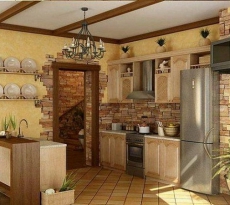
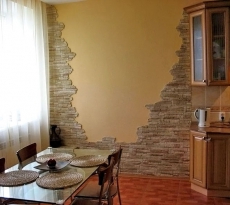
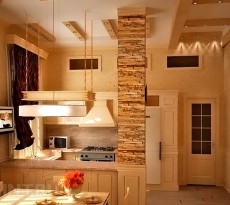
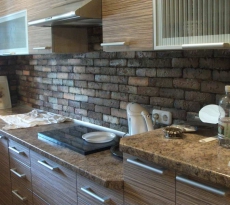


If the decorative stone does not match the overall style of the kitchen, then the appearance of the room will lose as a result.
Finishing the entire surface of the kitchen walls will give it a medieval spirit.
A good addition to this look would be to create niches in the wall.
You can decorate only part of the kitchen wall with decorative stone.
If you want to create a cozy atmosphere, then use the material to create mosaic patterns.
The doorway is often lined with stone if this decorative element is repeated in other areas of the kitchen.
The dining table area will definitely benefit from decoration.
If the table is in a corner, then you can veneer two walls, applying less decorative stone to one of them than to the other.
When choosing a kitchen design, keep in mind that large elements look good in a large room, while small stones are suitable for a small kitchen.
Bedroom
The bedroom is a special room in the apartment, where an atmosphere of comfort is important.
When choosing decorative stone for this room, give preference to warm colors.
An excellent solution would be to decorate the bedroom with decorative stone white, giving a feeling of cleanliness and freshness.
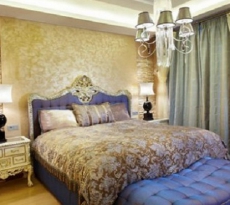
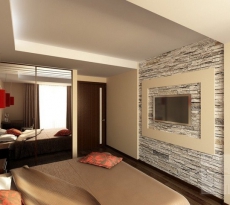
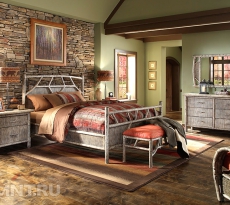

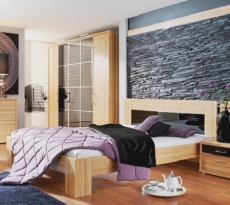
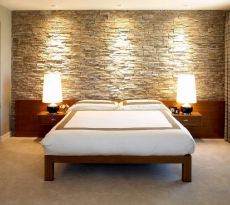
Traditionally, decorative stone in the bedroom interior is used to highlight the head of the bed area.
Decorative elements can be applied to the wall up to the ceiling or only part of the wall can be highlighted.
To avoid burdening your bedroom interior with stone, try using separate inserts or panels made of this material.
They will act as accents, but will give your room a special chic.
Decorative stone goes best with natural wood.

If the furniture in your bedroom is made of this material, then the room will look noble and elegant.
Sometimes the choice of color scheme for bedroom design elements falls on dark gray or black tones.
In this case, you should purchase light-colored furniture in order to avoid the gloom and dullness of the sleeping area.
Bathroom
The water-repellent properties of decorative stones make it possible to decorate such a high-quality decorative part of the apartment as the bathroom.
An artificial substitute for marble or granite will turn this room into a real spa.
You can decorate the entire wall above the bathtub or just part of it.
The niche above the bathtub, lined with decorative elements, looks impressive.
Modern designers also practice finishing the outside of the bathroom with this material.
The corner of the wall, decorated with decorative stone, as well as the washbasin area and mirrors above it, will look original.
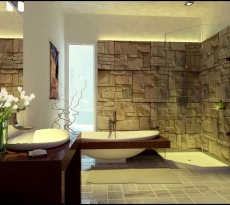
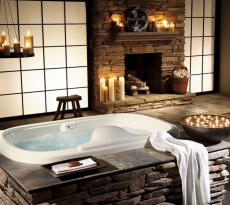
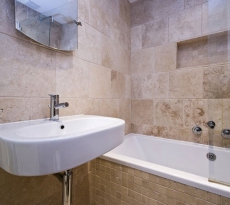
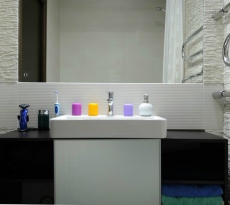
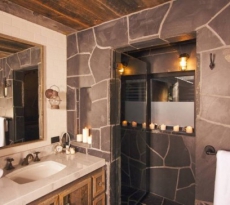

The seamless effect of the elements distinguishes this material from the usual tiles in the bathroom.
If you want to create an exotic atmosphere in the bathroom, then use bright shades of decorative stone.
The design of other interior items should be in the same style.
You can play up the marine theme by using artificial pebbles in your bathroom design.
In this case, it is better to make the decor lines wavy.
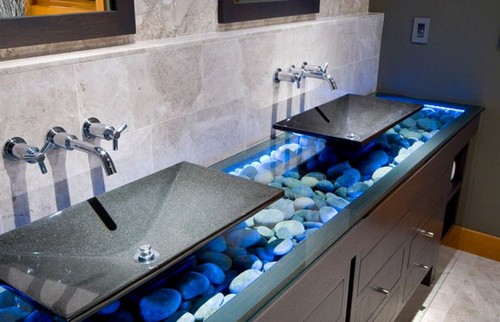
An interesting solution is to use rough large stone along with wooden elements.
Wooden mirror frames, ceiling beams and imitation cobblestones will create a unique spirit in the bathroom.
When using stones in the interior of an apartment, you should remember the consistency of the style and direction of the design.
Each room should have its own atmosphere, making up the overall ensemble of your entire home.